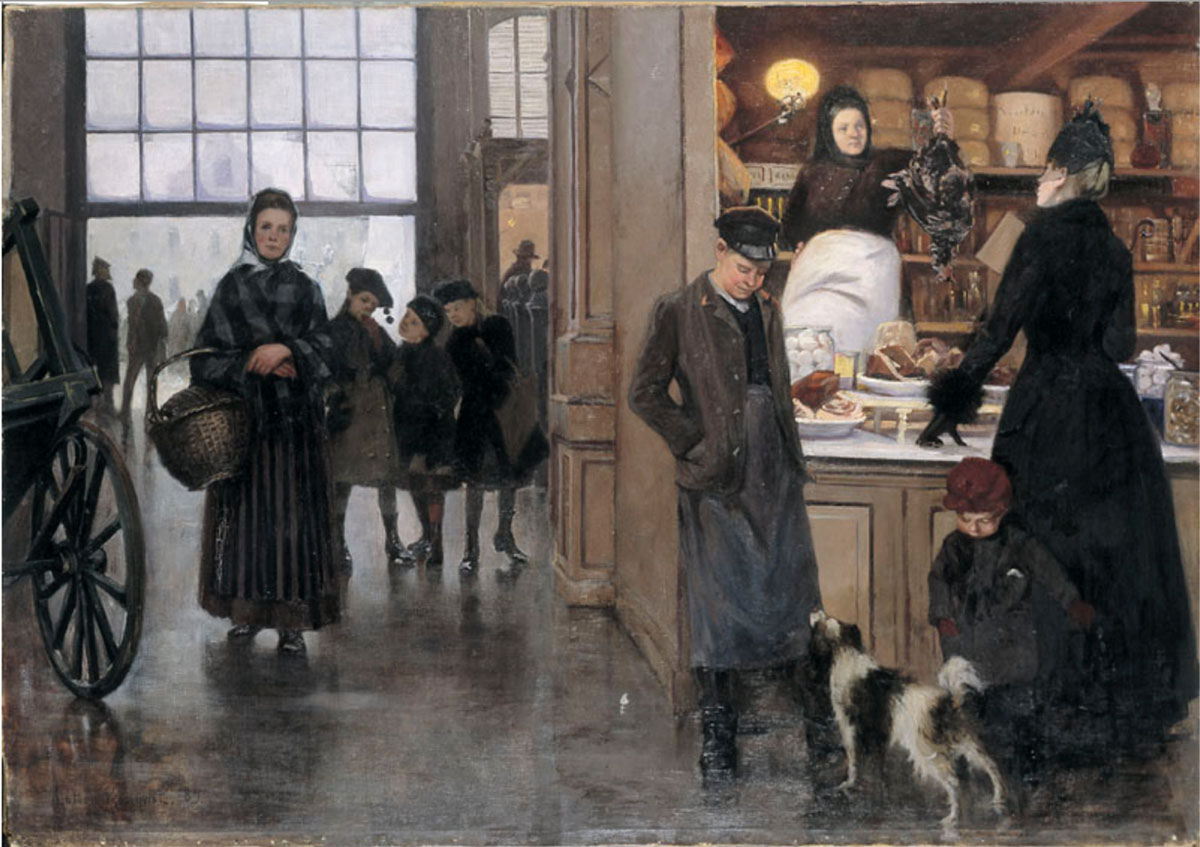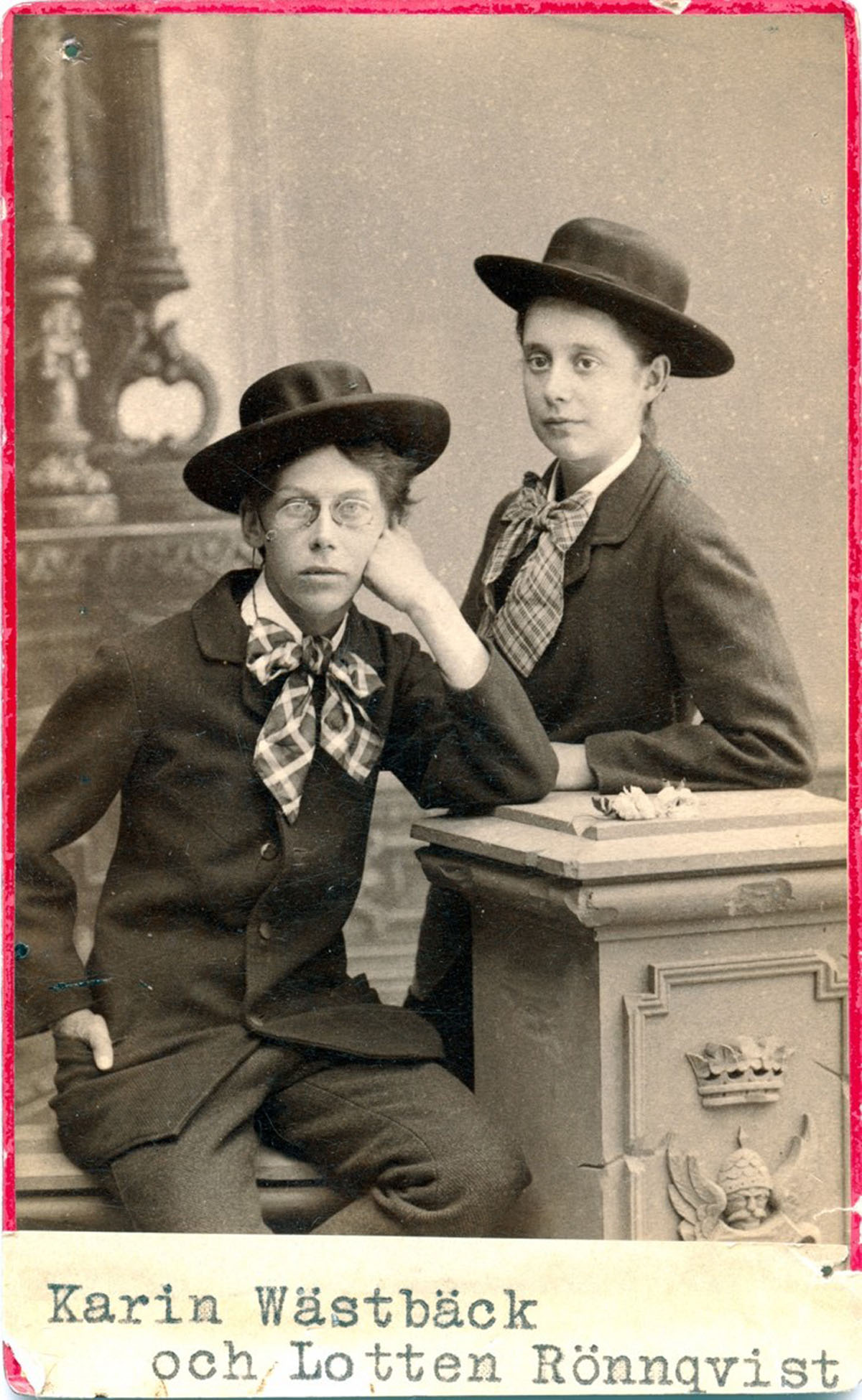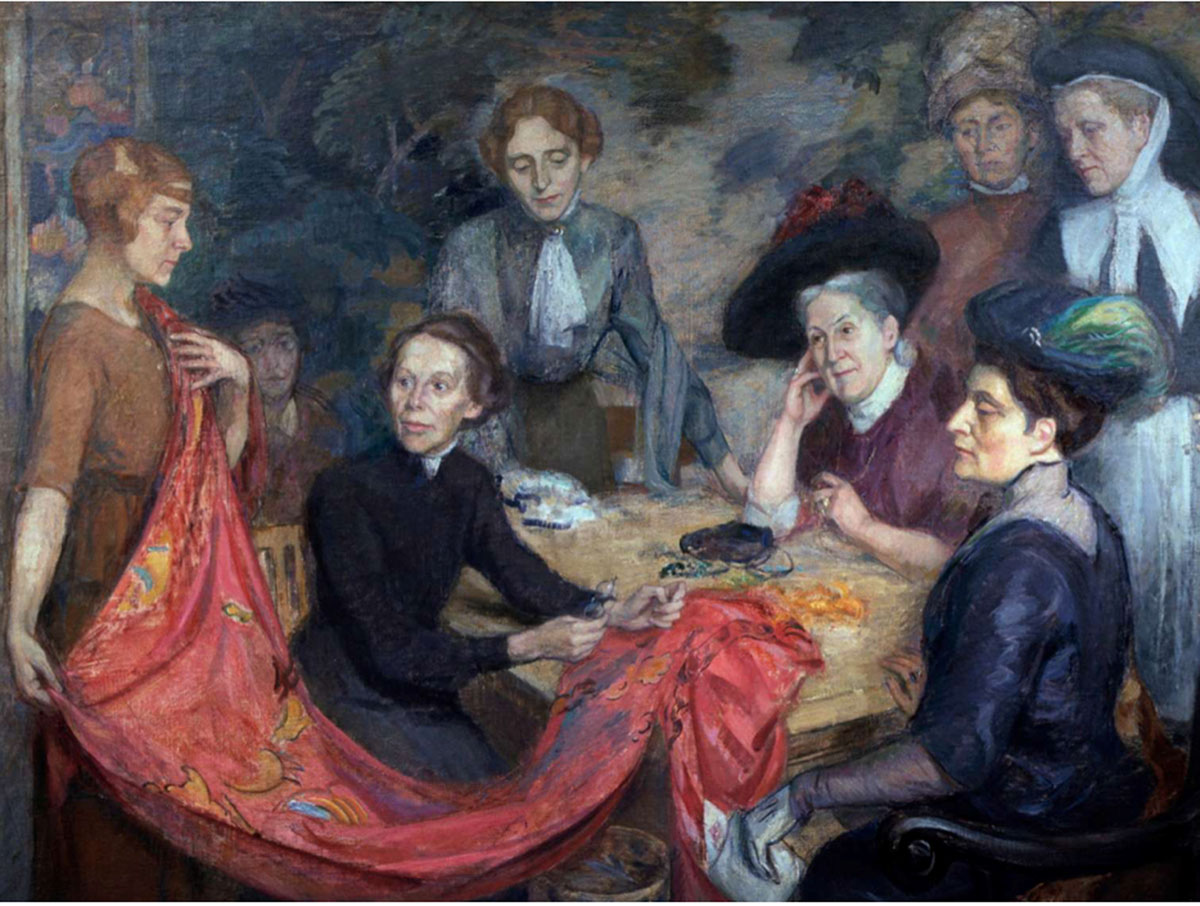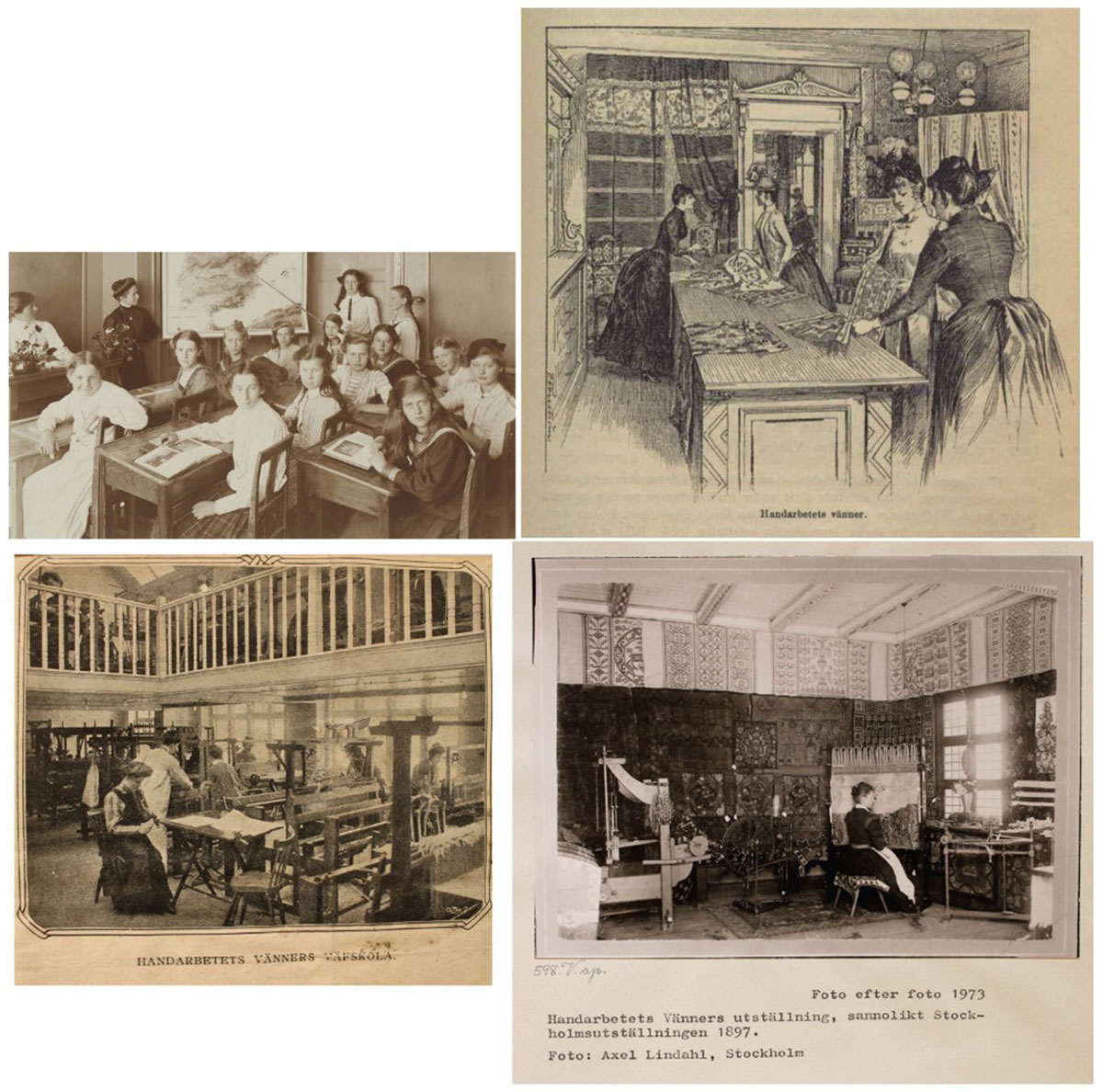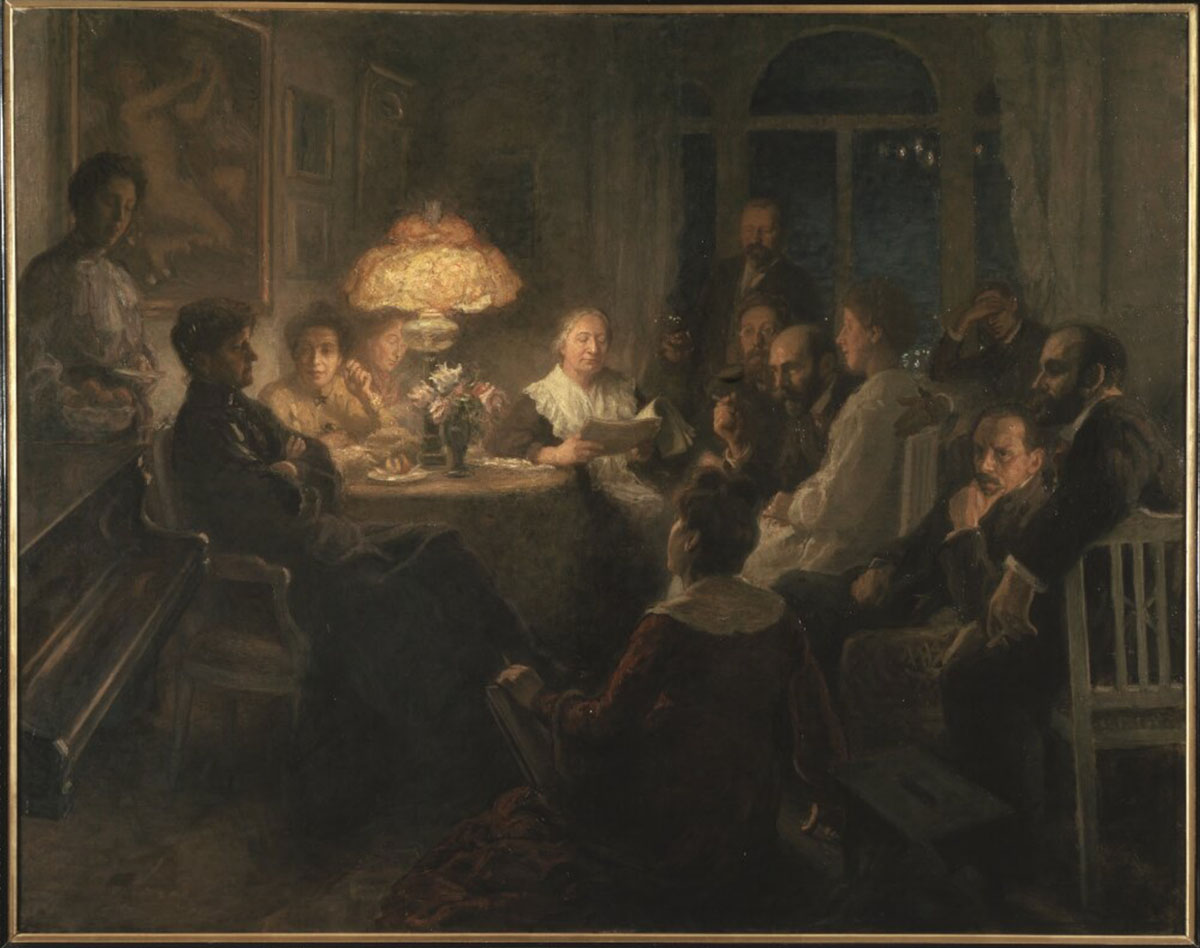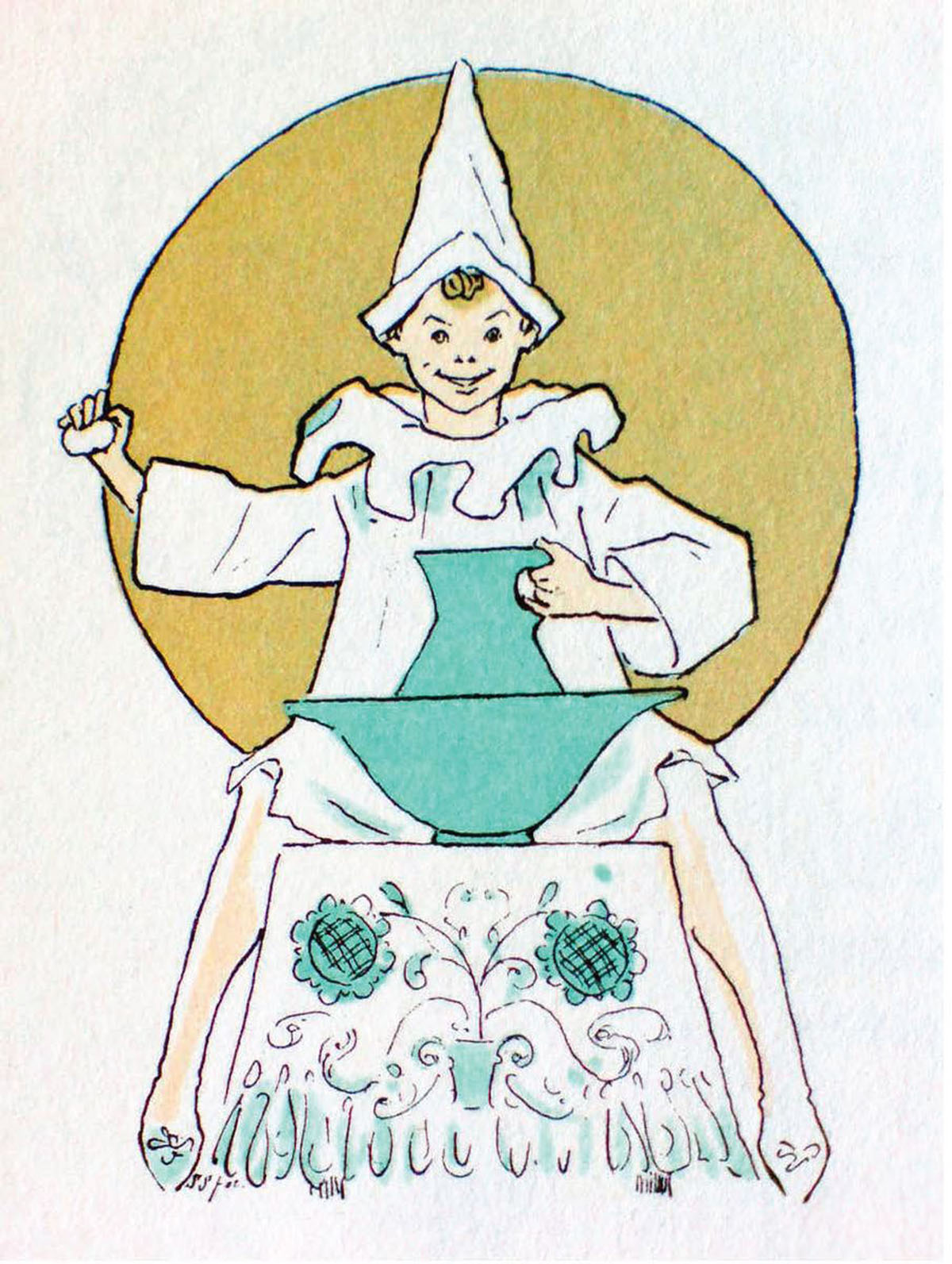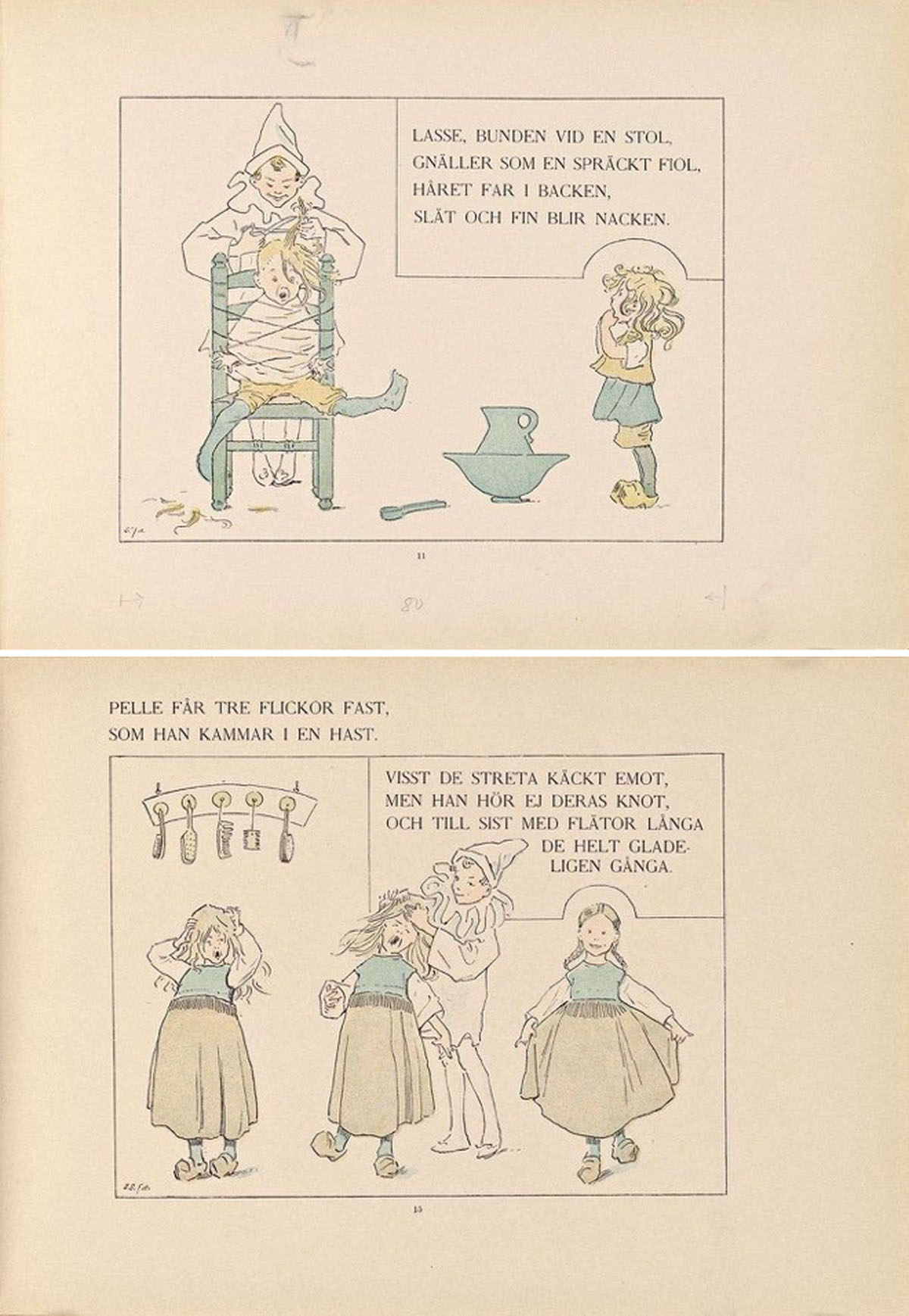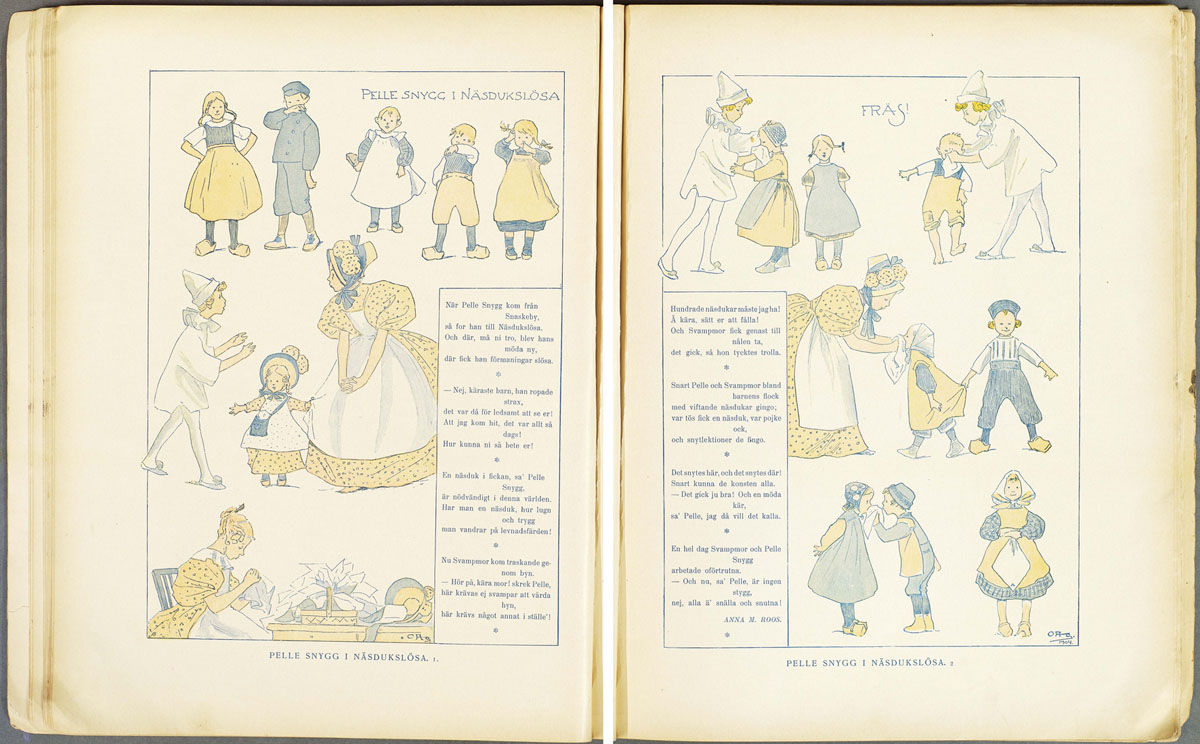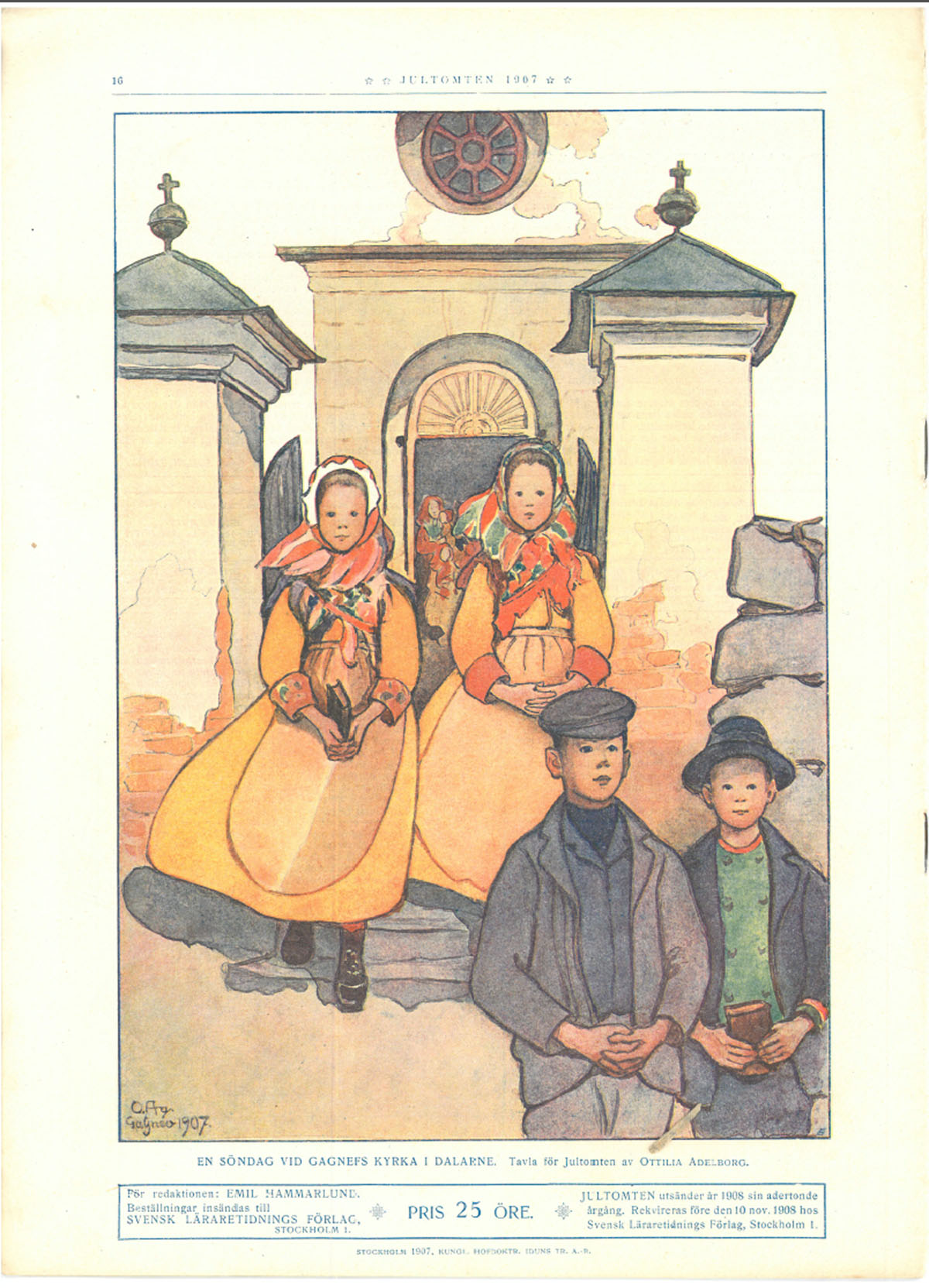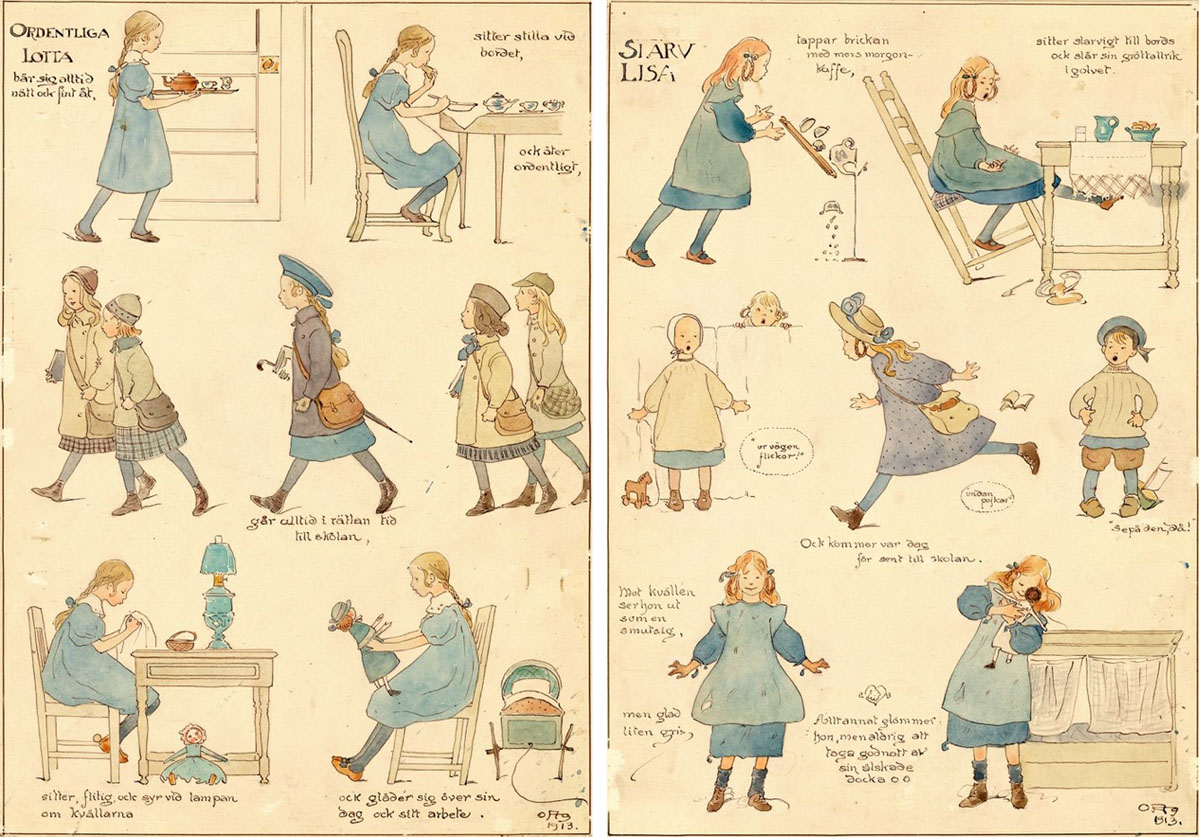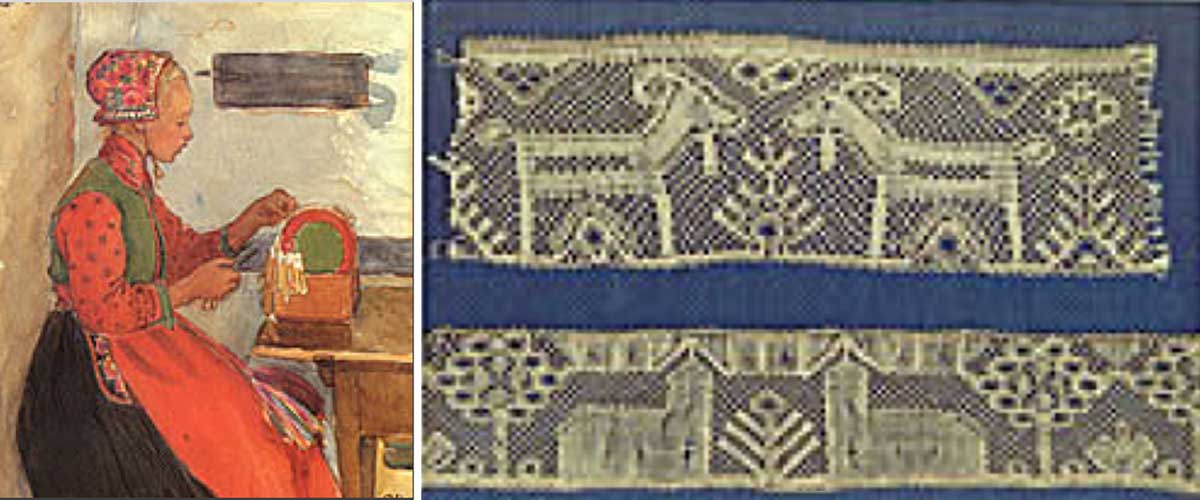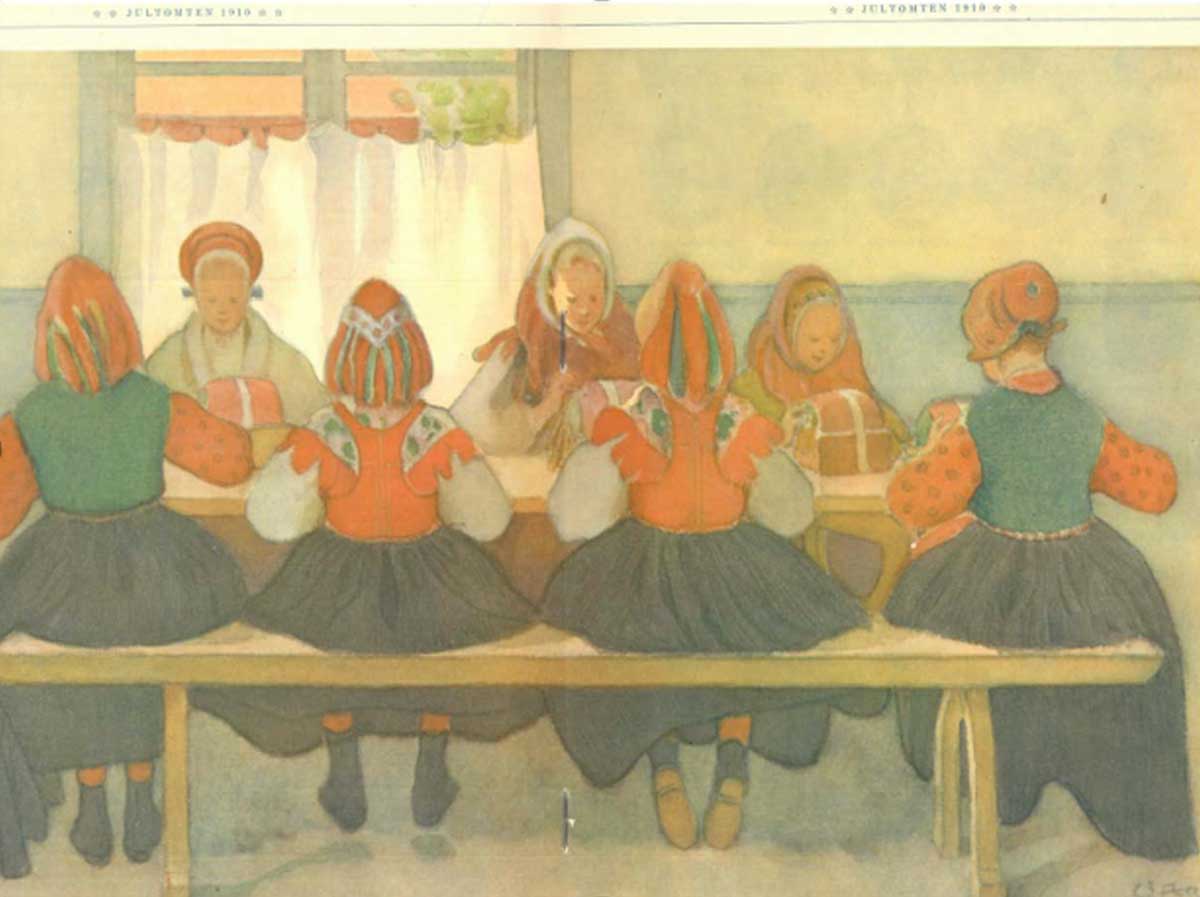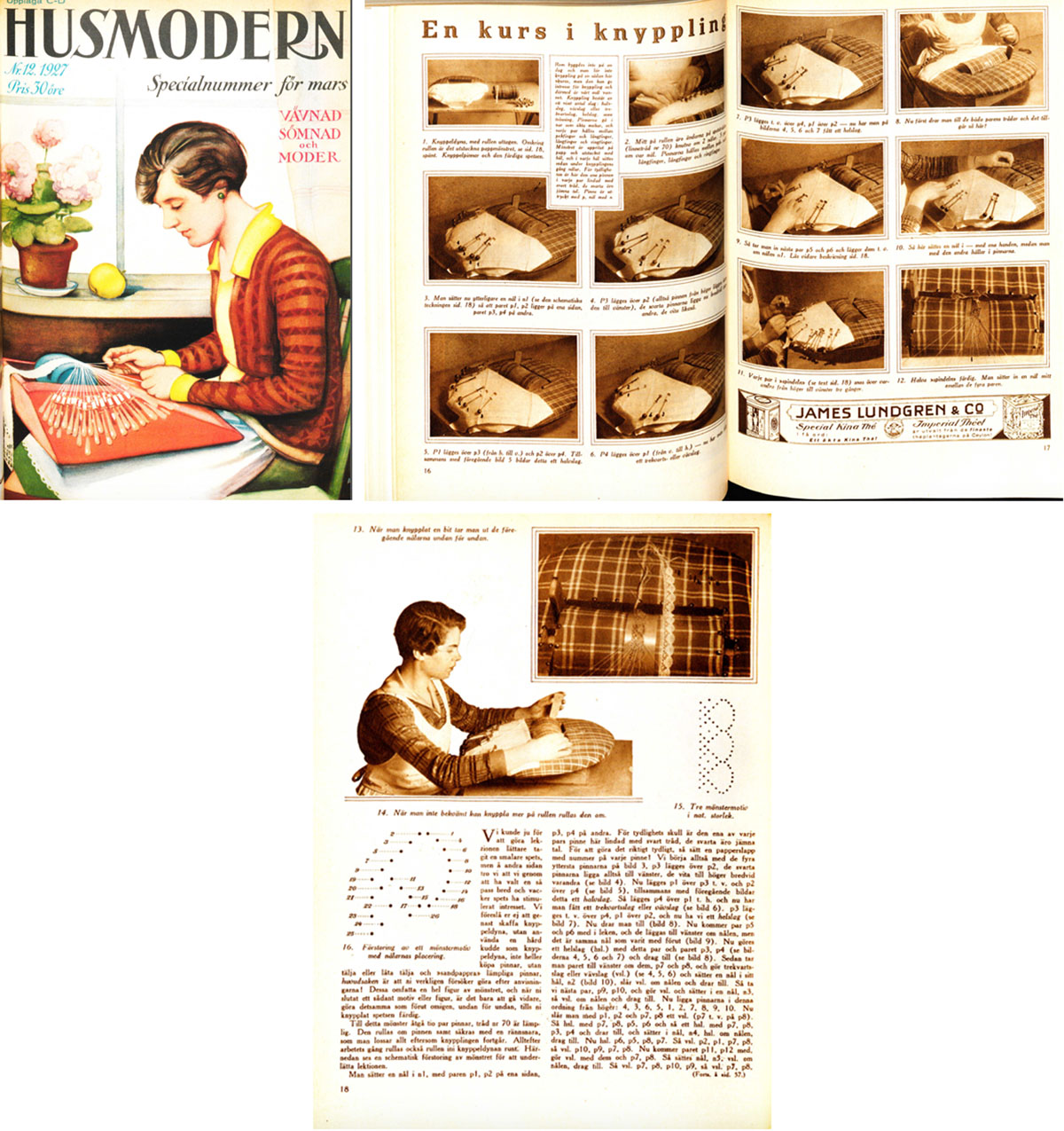“Women’s Work” and the “Spaces of Femininity”
The social dislocations and anxieties brought on by the forces of modernization, industrialization and urbanization in nineteenth-century Europe, and the ensuing challenges to the social order that modernity unleashed prompted a series of recuperative responses. One such response was the emergence of the field of folklore studies,1 born of the twin masculinist discourses of nationalism (McClintock 1993) and romanticism (Mellor 1997). The foundational premise of folklore studies originally held that its subject was located in a rapidly vanishing past (Kirshenblatt-Gimblett 1998). Method and practice followed: collect, preserve, archive, and re-present a romanticized, nostalgic vision of the (non-modern) past that both spatially and temporally emphasized the rupture effected by modernity to traditional life. Folklorists, in preserving those elements of an ancient and threatened (rural) heritage, were advancing the notion of cultural distinctiveness and “essence” which could serve as a palliative to the homogenizing tendencies of modernity. The predicament of folklore studies, however, lay in the fact that both the concept of the nation and tradition were “fundamentally modern,” with the field of folklore studies itself a “modernist project” (Anttonen 2005: 13). Folklore’s formation and maintenance thus required a series of discursive acts of “historiographical violence” (Karlholm 2014: 294) – erasures, omissions, and devaluations – which were then reproduced, reified, and normalized in academic discourse and practice. Critical among these was the gendering of the field by which not only were the contributions of women omitted, but women themselves were discursively degraded.
Barbro Klein sought to counter the “bland erasure of gender configurations” (Klein 2013: 120, citing Mills 1993: 176) that undergirds the history and discipline of Swedish folklore and folklife. Her work served as a corrective to the ways in which such erasures have denied the interconnections between femininity and modernity in a field that was so critical to the formation of modern nations. Klein not only personally fought for a voice within the discipline, but also mentored her female students, challenged the masculinist narrative underlying the concept of folklore, and in much of her research worked to reinsert women as active agents and participants in the history of the discipline. Her research focused on the work of two women activists in the turn-of-the-century Swedish home craft movement:2 Lilli Zickerman (1858–1949) and Ottilia Adelborg (1855–1936) (Klein 2013, 2010, 2000, 1999). Yet by working within the constraints of a discipline that was already always gendered, the women’s histories that Klein sought to reclaim were merely additive to an otherwise unchanged linear narrative. As a result, these women’s contributions could only be interpreted as either reform (progressive/modern) or rescue (conservative/traditional) within an overall system that could not account for alternative responses to the conditions of modernity.
In this article I adapt Griselda Pollock’s trenchant feminist critique of the world of art to the field of folklore studies to argue that women’s histories cannot be “merely mapped onto existing schemata” that are “structured in and structuring of gender power relations” (1988: 55). Instead, “the historical recovery of data about women producers […] coexists with and is only critically possible through a concomitant deconstruction” of prevailing discourses and practices of the field (Pollock 1988: 55). In pursuing this double project – reinserting forgotten women and challenging the dominant narrative enabled by their omission – this article takes the work of Barbro Klein as a point of departure to argue that Swedish women of the fin de siècle worked within overlapping and interconnected women’s networks through which they fashioned their own responses to the pressures of modernity within the particular configurations of gender, and that these networks transcended disciplinary bounds. I expand on Griselda Pollock’s “spaces of femininity” – those spaces “from which femininity is lived as a positionality in discourse and social practice” (Pollock 1988: 66), to challenge the false dichotomies of past–future and tradition–modernity which have been central to the disciplinary narrative of folklore studies.
In discussing women-created spaces and networks in fin de siècle Sweden, this analysis is also informed by the work of Maud Eduards (2002), who sees the importance of women’s organizations in undoing hierarchies of gender by providing the space in which to maneuver: “elbow room, freedom of choice, self-determination, new or larger arenas to move around in, exceeding boundaries, and opportunities to influence the political agenda” (Eduards 2002: 16, translation by author). Lilli Zickerman and Ottilia Adelborg, along with many other women, were active within multiple organizations, creating both formal and informal spaces of femininity. Working in apparently disparate fields, from reconfigured-in-modernity hand crafts to emergent industries, they produced items of everyday culture – children’s books, magazine and postcard illustrations, pattern design for fashion and handicrafts, textiles and other items used in the home or related to childrearing, or that in some other way were related to and used by women, which could then easily be denigrated and dismissed as “women’s work.”3 This gendered prejudice was incorporated into the field of Swedish ethnology (Klein 2000) wherein the imperatives of “authenticity” denigrated industrially produced and mass-marketed products, created by a new female working class, as “low culture.”
A disciplinary and compartmentalized approach to the products of women’s labor has disallowed connections across a variety of products despite the fact that women’s own embodied practices made these connections. By contrast, this article takes inspiration from Allan Pred’s concept of “articulation” (1991a, 1991b) – the joining of elements otherwise seen as discrete – to explore how women’s engagement with and through these networks embody and illustrate the iterative interactions between the products of industrial capitalism, their production by women’s labor, and their consumption, often by the same women acting as consumers. Women’s networks thus provide a context for articulations that “derive from the experience of new everyday practices and power relations, from the experience of new material circumstances and new everyday rules of the game” (1991a: 5). I argue that by investigating “women’s work” in the context of industrial capitalism we can see how old forms were dismantled and newly configured, and how they were critical elements in the construction of modern identities. Engaged neither in reform nor rescue, these networks of femininity and the “women’s work” they performed represented a sustained engagement with the “shifting complexities of the modern in relation to gender politics” (Felski 2009: 18).
Finally, this article shows how “women’s work” was transformed into labor, providing income for a new generation of trained female workers in new industries. It argues that “women’s work” was fundamental to the project of modernity and the construction of the modern Swedish state, and insinuated itself into the most intimate and ordinary aspects of day-to-day life. In other words, it performed the ideological and political work of modernity even as it was excluded from its grand narrative.4
Folklore’s Gender Problem
By the fin de siècle the phenomenon of the “New Woman,”5 the political and public organization of women’s-rights and suffrage groups, and the increasing number of women in the workplace (particularly working-class women in new industries) were all disrupting and challenging the conventional gender order. Folklore studies, conservative and past-oriented, found common ground with the ideological, recuperative response to this crisis of gender with the evolutionist reification of separate gendered spheres, which effectively trapped woman in her sex (biology), and in some ways outside of time (understood progressively). This construction of a “natural” division of labor consigned woman to the domestic realm, to the role of passive conduit (the grandma spinning tales at the hearth), and to immanence – all “hegemonic strategies designed to control and to appropriate female generativity” (Babcock 1987: 394). The construction of separate gendered spheres thus served to resolve the temporal dilemma of the folklore discipline that advanced the interests of the (modern) nation while advocating the preservation of tradition. Thus, fundamental to and constitutive of the field was a gender ideology in which Woman was aligned with the non-modern. Woman was one of folklore’s Others, but in a unique position: protector of the hearth and tradition, while trapped outside of time and without agency.
As with most disciplinary parables of modernity, the quest of folklore studies was not so much for the vanishing past itself, but for how that past was to be harnessed for future citizens of the state. In this quest, the heroes were exclusively male. The “narrative of the birth of folkloristics” (Abrahams 1993: 8) asserted the unnaturally conceived paternity of folklore studies: Herder, Grimm, Thoms, von Sydow, Krohn, Olrik. The masculinization of the field was thus complete: the forbearers and their heirs were male, while women were written out or deprived of agency in their limited role as conduits, vessels, or “passive bearers” of tradition. Additionally, because Woman was in theory relegated, temporally and spatially, to the domestic sphere, it followed that her cultural productions were dismissed as “women’s work,” while the fruits of working-class women, working in industry, were also denigrated as mass culture. Thus, the ordinary, the quotidian that constituted day-to-day lived experience was excluded from critical purview and trivialized, effectively removing any discussion of the role these aspects of ordinary culture played in creating and shaping modern subjectivities.
Following the general influence of folklore studies in Europe, the Swedish folklore and folklife discipline was constructed on a similarly masculinist trajectory: its lineage preceded Herder and was mythologized in Gustavus Adolphus’s calling upon parish priests to collect folklore in the seventeenth century (Thompson 1961). Fin de siècle Swedish culture-builders such as Artur Hazelius, the founder of Nordiska museet (1873) and the open-air ethnographic park Skansen (1891), were “convinced that it was among the simple rural dwellers that they would find the sensuous earthiness that would counteract the artifice of modern urbanism” (Klein 2000: 174). The project for Swedish intellectuals at the fin de siècle was thus both interventionist and pedagogical – to salvage, collect, and preserve select traditional materials and to educate Swedes of their heritage in response to modernization. Women, in this gendered historical formation, served as a reactive counterweight to inevitable progress, their words and products constituting the objects of folkloristic rescue operations.
Disassembling the Public–Private Sphere Divide
The maintenance of this fiction of gender sequestration, despite its being counterfactual to the clear presence of women operating in the public sphere, required significant ideological work across all aspects of society. Not limited to the field of folklore studies, this gendered discursive terrain enveloped a wide range of fields, their intersections converging on a singular, dominant gender ideology. A few examples from Sweden – from the canonization of certain foundational texts in folklore studies and the exclusion of others; to representations of women in art; to the contortions involved in maintaining the appearance of female areas in the very public space of the 1897 Stockholm World’s Fair – will illustrate some of the overlapping ways in which asymmetric gender relations of power were discursively maintained, and, importantly, how their juxtaposition with contemporary counternarratives can be a means of deconstructing the monolithic, masculinist narrative of modernity.
Throughout Europe the publication of folk and fairy tale collections, based on the model initiated by the Grimms’ Kinder- und Hausmärchen (1st ed. 1812–1815), was a crucial component of various nation building projects. In Swedish folkloristics, G. O. Hyltén-Cavallius and George Stephens’s Svenska folksagor och äfventyr (Swedish folktales and fairy tales, 1844–49) is most often cited as a similarly seminal text (Hult 2016: 891). Based mostly on material collected from already published sources, in archaic language and in a scholarly, comparative form, it contrasts sharply with the work of Eva Wigström (1832–1901), whose collections of tales, legends, and ethnographies from the 1870s to the turn of the century have not until recently received much attention (Ehrenberg 2003). Erased through a toxic mix of sexism, classism, and regionalism,6 Wigström’s work and her story complexify and challenge foundational aspects of Swedish folkloristics. Hyltén-Cavallius was a scholar, statesman, and Romantic nationalist, who circulated in foreign capitals and in academic circles in Uppsala and Stockholm. Eva Wigström was the non-academic daughter of a farmer from the region of Skåne, who published for a living rather than as a political act. At this intersection of gender, class, region and political ideology was thus the contest over the terms of (modern) Swedishness.
Wigström and her work exemplify the changing position of women in the public sphere, while the fact that her large body of work remains relatively unknown and unstudied speaks to the institutional neglect such “women’s work” suffered from. As with many women, Wigström balanced motherhood with work, and her family’s economy was significantly dependent on the income she received from her publications. As a result, out of economic necessity she published in a variety of different media and genres. She was a prolific collector in the field, and her folktale collections problematize the conventional configuration of Woman as passive bearer. Her authored tales for children exemplify the complex relationships between women’s work and women’s networks that operated in new publishing and reform venues. Some of these tales were published in the children’s magazine Sol for Föreningen till det godas befrämjande (Association for the promotion of good) founded by the reformer Concordia Löfving. This charitable organization provided agricultural land to the poor and welfare and education for their children, and Wigström’s tales in Sol reflected this utopian, bourgeois ideology (see Ehrenberg 2003: 171–173). Furthermore, Wigström’s authored tales are located in the realm of pedagogy, and thus sit solidly in the progressive field of educational reform.
In the Swedish world of art, the representations of women by two of the most revered artists of the fin de siècle, Carl Larsson (1853–1919) and Anders Zorn (1860–1920), similarly worked to reinscribe the separation of the gendered spheres, even as their female counterparts in the art world challenged these representations. At first glance, Larsson’s and Zorn’s images appear to be in opposition – Larsson’s domestic idylls of his wife Karin, and of his family living the image of “Swedishness,”7 seem worlds removed from Zorn’s prostitutes in public spaces8 and his much-lauded nudes. And yet they reaffirm the power of the male gaze and the male artist. Both Larsson’s and Zorn’s women are simulacra – fictionalized representations which reinscribe the domestic bourgeois feminine ideal. Larsson literally recreates his bourgeois family in his tableaus, and Zorn painted both high-status women properly in their place and punishing images of the prostitute who transgressed the private sphere by working in the public street. In Zorn’s exploitative and eroticizing images of young rural girls, their poses emphasize their powerlessness. His representations of women lay bare the unequal gender relations intersected by wealth, power, age, and class, particularly in the juxtaposition of his commissioned portraits of the wives of important men with his nude models, the so-called Zorn kullor, who were young (unmarried) local women from Dalarna. The exaltation of these artists and their work has further served to solidify an unequal gender power dynamic.
In contrast, Swedish women artists of the time actively engaged in painting women at work (Conrad 2021) both in the studio and in public. In dialog with their male contemporaries, their paintings challenged the domestic ideal they themselves were resisting personally and professionally. Lotten Rönnquist’s (1864–1912) I Hötorgshallen, Stockholm, 1889 (see Figure 1) encapsulates the changing nature of social and commercial spaces as well as the novel ways in which women in public negotiated in them.
Inside the newly completed (1884) cast iron and glass market hall in the center of Stockholm, commerce is not only on display, it is rationalized. In Rönnquist’s scene, a bourgeois mother, whose back is turned toward the viewer, negotiates with a saleswoman, while walking toward the viewer is a young domestic, presumably shopping for her employer. The girl’s and the woman’s clothes and demeanors are in sharp contrast to each other, echoing the overall display of class relations. Consumption for the domestic sphere is here a public event engaged in by women. Rönnquist’s photographic portrait alongside her fellow classmate and fellow cross-dresser Carin Wästberg (aka. Karin Wästbäck) (1859–1942) also actively and wryly challenges the code of femininity depicted by Larsson and Zorn (see Figure 2).
Other women artists also painted themselves as artists at work, at home, in their studios, and en plein air, subverting conventional gender hierarchies and challenging the limits of domestic interiority (Rech 2018). They documented and testified to the changing nature of women’s work: Eva Bonnier’s (1857–1909) Couturières (1887)9 presents an apparently domestic scene of women sewing in order to upend expectations of women’s work. Rather than depicting women sewing as a domestic chore, her dressmakers are making a living as seamstresses using magazine-inspired patterns for their handiwork. Rather than a nostalgic, imaginary domestic scene, this work depicts women earning money using the latest in mass-mediated and industrially designed textiles and patterns that were produced in new female spaces of labor. Similarly, Hanna Hirsch-Pauli’s 1919 painting Handarbetets Vänners konstutskott (Art committee of the friends of handicraft)10 could be misinterpreted as portraying upper-class ladies on a shopping trip being shown the latest fashions by a clerk, but in fact depicts a tense business meeting between union members and members of the Handarbetets Vänner (Friends of handicraft), attended by the committee chair women, board members, two textile designers – Maja Sjöström (1868–1961) and Carin Wästberg (Karin Wästbäck) – as well as the artist, who has inserted herself into the background (see Figure 3).
Handarbetets Vänners konstutskott (oil on canvas), by Hanna Hirsch-Pauli (1919). (Permission from Jönköpings läns museum).
The instability and unsustainability of the gendered oppositional pairs of tradition–modernity and public/private were also brought into sharp relief at the 1897 General Art and Industrial Exposition of Stockholm, which, like all world’s fairs, showcased the marvels of new technologies and industry. Predicated on progress, nationalism, and (mass) consumption, and driven by the industrial magnates of the day, ethnographic displays such as those at Nordiska museet and Skansen were anachronistically subsumed into the phantasmagoric and temporary landscapes of desire that celebrated modern mass production and industry. The contested and ambiguous position of women working in industry and in the public sphere more generally was exacerbated in these very public spectacles in which the maintenance of exclusive gendered spheres worked against expansive consumerism. Women’s industrial output, including those of textile artists from Handarbetets Vänner, were displayed in the Great Hall of Industry alongside products from porcelain workshops and glassworks, many of which employed women, as well as alongside other industrial products such as weapons and machinery (Hasselgren 1897). Special lounges, such as the Idun Ladies’ Pavilion, sponsored by the weekly women’s magazine of the same name, offered women shelter from exposure to the public realm, as did the pavilion sponsored by the Herman Meeths Co., a retail chain for sewing machines (appropriate to “women’s work” the pavilion was shaped as a sewing box [Pred 1991b: 57]). But in order to reach these spaces, women had to of course walk around inside the fair, whose raison d’être was to expose all visitors to the wonders of technology, progress, and consumerism as they passed through.
Networks, Organizations, and Strategic Spaces
In many of her articles from the 1990s and 2000s, Barbro Klein focused on two women activists in the turn-of-the-century Swedish home craft movement – Lilli Zickerman and Ottilia Adelborg. Focusing on Zickerman’s and Adelborg’s work in home crafts within the temporally determined imperatives of folklore and heritage studies, however, Klein was working within an already gendered disciplinary discourse defined by the problematic concept of tradition. But Zickerman’s and Adelborg’s work cannot be restricted to home crafts or preservationist modes. They were active across the multiple and mutually reinforcing spheres of art, education, industry and commerce, as well as to the preservation of heritage. Furthermore, they participated in these endeavors through networks of women who worked, who were active in women’s issues, and who operated in communities of support – “spaces of femininity” – that sought to mitigate the socially imposed constraints of gender which persisted despite radically shifting social realities.
By the mid-1800s, industrialization, outmigration, and urbanization in Sweden were changing the social, economic, and professional landscape for women. Growing population pressures in rural areas led to large-scale emigration among males, as well as a disproportionate number of single women living in cities, particularly Stockholm (Hagemann 2005: 148). This new reality prompted legal reforms specifically directed toward gaining rights for unmarried women, including the right to work in crafts and commerce (1846) and to enjoy the same formal rights as men in the private business sector (1864).11 These reforms coincided with increasing demands for labor from a variety of industries, several of which – textile manufacturing, laundry operations, dairy work, and some aspects of the printing industry – were already dominated by women.
In this nexus, Swedish women’s rights proponents such as Sophie Adlersparre (1823–1895) and Ellen Key (1849–1926) recognized the symbiotic potential of labor and liberty and began advocating for women’s education and workspaces as the keys to liberation and autonomy. Taking advantage of new technologies of mass communication, Adlersparre and Rosalie Olivecrona (1823–1898) founded Tidskrift för hemmet (Magazine for the home, sometimes translated as “Home Review”) in 1859, the first women’s magazine in Scandinavia, which reached large audiences due to advances in publishing and distribution. Tidskrift för hemmet served as a platform for debates on women’s rights, gender roles, and feminism in Sweden, while its advertisements and classified sections, which were addressed exclusively to women, were a source of information on jobs, educational opportunities, and living accommodations both at home and abroad. It also connected women in a virtual, mediated community, incorporating them into modern processes in their daily practices and in new forms of consumption.
Linking women’s rights not only to politics and suffrage, but to education and vocational and technical training, Adlersparre thus instrumentalized pedagogy, mass media, consumerism and industry in order to engage women as active participants in the modern world. Newly configured spaces of work – schools, women’s associations, women’s workspaces, shops, and exhibitions (see Figure 4) – allowed greater freedom of movement, autonomy, and independence in the public realm even as the notion of the feminine domestic sphere was becoming more inscribed as a bourgeois ideal. Empowered to work, female workers of all trades joined together in their fight for equal working rights. This was often done through their common affiliation with Fredrika Bremer Förbundet (the Fredrika Bremer Association), the women’s rights organization founded by Adlersparre in 1884.12
Clockwise from top left: Geography lesson at Anna Sandström’s school, Stockholm 1911 (© Stockholms stadsarkiv); Handarbetets Vänner shop, ca. 1890s (https://www.hv-textil.se/var-historik/bildarkiv/brunkebergstorg-18-1887-1906/); Handarbetets Vänner display at the 1897 Stockholm Exhibition (https://www.hv-textil.se/var-historik/bildarkiv/handarbetets-vanners-utstallning-sannolikt-stockho/); and Handarbetets Vänner weaving school/workshop ca. 1900 (https://www.hv-textil.se/var-historik/bildarkiv/vavskolan-kring-sekelskiftet/).
Many seemingly disparate spheres of activity across class boundaries were linked by the women who inhabited them, and women were often simultaneously active across multiple, often overlapping networks that mutually reinforced one another. Several were inspired to form additional groups, including Stockholms Allmänna Kvinnoklubb (General women’s club of Stockholm) in 1892; Föreningen Svenska Konstnärinnor (Association of Swedish women artists) in 1910; Kvinnornas textilfackförbund (Women’s textile workers union) in 1902; various husmodersföreningar (“housewife associations”), as well as publications such as Idun, a magazine “for women and the home” in 1887, and Husmodern (Housewife) “for Swedish homes,” in 1917. Within these spaces, in which women’s work simultaneously served political and economic aims, the terms of a new gender order were being shaped and contested. Women’s associations and networks thus provided the mechanism – a “weave of alliances” (Wängnerud 2012) – by which women could enter commercial, industrial and political arenas, which in turn were being brokered and marketed in novel ways.
A Weave of Alliances — Lilli Zickerman
Sophie Adlersparre also founded Handarbetets Vänner in 1874 with the twin goals of providing women the opportunity to support themselves and developing Sweden’s textile art market. Lilli Zickerman trained at the Handarbetets Vänner school for sewing and weaving in the 1880s. The product of a modern trade school, she then utilized modern methods and media to initiate her career. Returning to her hometown in Skövde in 1886, she began advertising her textile weaving, sewing, and lace-making classes based on Handarbetets Vänner’s methods in the local newspaper. From 1887 to 1897, Zickerman operated her own boutique in Stockholm, selling handcrafts of her own design, which she also displayed in the Halls of Industry (I and XIII) along with hundreds of other women at Stockholm’s 1897 World Exposition (Hasselgren 1897). In these public, commercial spaces in which industry and manufacturing were showcased to excite consumerist desire, women’s work transformed once household items into commodities and articulated traditional forms into the present, not in the context of preservation and salvage, but in order to establish a place for themselves in the modern world.
In 1899, concerned that the quality of manufactured products could easily be degraded without intervention and also that the work of handicrafters would not meet consumers’ standards and expectations, Zickerman established Föreningen för Svensk Hemslöjd (The Swedish handicraft association) to serve artisans and their customers (Palmsköld 2018). Shortly after its founding, Ottilia Adelborg became a member. The association developed quality guidelines and new patterns and manufacturing techniques, but also set up a new shop in Stockholm to sell products made by women throughout the country. The Stockholm store was the first of many in Sweden to support and benefit from the newly emerging tourism industry. Women’s organizations such as these thus operated fully within modern consumerist regimes. They transformed the nature of work and the nature of products and served as mediators in that transformation. In this sense, handicrafts were not ethnographic objects to be preserved for their links to the past, but the medium by which women’s entry into the public work and commercial spheres was achieved, ultimately with the goal of political access.
In all of these endeavors, the objects produced were reconfigured and given new significance in a modern context and space – the school, the workplace, the shop, the museum, the exposition – and it was women’s networks that served to facilitate this transition. Not easily defined as idealistic reform or nostalgic rescue, women’s organizations promoted women’s economic empowerment while defining the limits both of the product and its mode of production. In the production of home crafts and in the representation of that production, offered both on commercial and preservationist platforms, women were instrumental in shaping modern sensibilities.
Networks of Women Artists
The basis for many of these women’s networks was often personal friendships forged in schools that had recently opened to women. One of these was Slöjdskolan (Handicraft school) in Stockholm. Opened in 1854, the school conducted day, night, and weekend classes to allow those already working to gain practical skills. The school admitted its first female students in 1858, and by 1864–1865 had 635 male and 426 female students, most of whom came from the working classes.13 Many graduates of the handicraft school who trained as weavers and textile designers found employment at Handarbetets Vänner, which supported “female entrepreneurship and emancipation, innovatory textile design, and advanced technical handicraft”.14 These artists designed products for the downtown Stockholm Handarbetets Vänner store, where bourgeois women could purchase ready-made handicrafts and patterns. In this way, both producers and consumers were engaging in a broader performance of commoditized heritage.
In 1864, partly as the result of Adlersparre’s petition to the Parliament, the Royal Academy of Art opened its women’s section – Fruntimmersavdelningen vid Kungliga Akademien för de fria konsterna. Entrance to the Royal Academy provided women not only with formal art training, but also with financial support in the form of living and travel stipends, workspace, and the organization of exhibitions to publicly show and share their work. It was also an environment in which life-long personal and professional alliances were formed, not least the result of the shared spaces – ateliers, apartments, and studios – through which these single but no-longer-solitary women obtained more freedom in public. Some of these relationships began even before women entered the Royal Art Academy at the Slöjdskolan, which not only trained women in the skills necessary to enter into commercial art in new industries, but also was preparation for those advancing to the Royal Academy.
The generation of women who entered the Academy in the decades after it first began admitting female students included Jenny Nyström, Karin Bergöö (Larsson), Eva Bonnier, Hildegard Thorell, Fanny Brate, Hanna Hirsch (Pauli), Hilma af Klint, Ottilia Adelborg and others. The friendships developed during these formative years would prove to be long lasting and would constitute the basis for many complex networks of associations that extended beyond the art world to include social reformers, educators, publishers, and activists, whose utopian reformist ethos extended to political, aesthetic, philosophical, scientific, economic, and psychological concerns.
Upon entering the Academy, however, the women in this cohort immediately found themselves in an art world in turmoil. Many of their male counterparts were calling for modernization and reform within the Academy (the so-called Opponenterna, see Boström 1945), and sought to break through the constraints imposed by the conservative academic style. Thus, despite their victory in gaining access to the Royal Academy, female students encountered institutional stagnation. This was compounded by outright hostility from male students (Österberg 2016) and the constraints of gender expectations in Swedish bourgeois society in general. Because of these conditions, many women gravitated to Paris, the “city of choice for the ambitious artist,” where “women could dedicate themselves to their artistic pursuits without feeling that they had neglected the[ir] ‘womanly’ duties” (Hansen 2017: 76).
In Paris, Swedish women artists expanded their existing networks to include other Scandinavian women artists with whom they often shared instruction at the private academies and studios, as well as living spaces. When painter Hildegard Thorell (1850–1930) arrived in Paris in 1879, she lived in the same guest house as fellow Swedish artist Jeanna Bauck (1840–1926) and Danish artist Bertha Wegmann (1846–1926). Wegmann would tutor Thorell, while all three studied at Madame Trélat de Vigny’s workshop, along with the Norwegian painter Harriet Backer (1845–1932), the Finnish painter Helene Schjerfbeck (1862–1946) and Finnish painter and author Helena Westermarck (1857–1938). Hanna Hirsch-Pauli (1864–1940), Eva Bonnier (1857–1909), Fanny Brate (1861–1940), and Finnish artist Venny Soldan (1863–1945) were all students at the Académie Colarossi. Hirsch, Bonnier, and Soldan shared living and studio space in Paris at different points in the 1880s. Thorell also lived with artists Anna Munthe-Norstedt (1854–1936), Elisabeth Keyser (1851–1898), Julia Beck (1853–1935), and Harriet Backer at various times while in Paris.15 In her regular letters to her husband Reinhold, Thorell describes friendships with two further Norwegian artists – Kitty Kielland (1843–1914) and Asta Nørregaard (1853–1933). Thorell maintained a sustained correspondence with several of these women after returning to Sweden. These letters, all archived in Nordiska museet, Stockholm, provide insights into the ways in which such friendships allowed women, many of whom were single, to venture out more freely in public, on excursions around Paris, and to the countryside.16
Ottilia Adelborg – A Hub in the Networks of Relations
Throughout her lifetime, Ottilia Adelborg’s personal, professional, and political engagements would connect her in a web of relations that were grounded in family and friendship. Unlike many in her cohort, Adelborg did not go on to Paris after the Academy,17 but maintained her school friendships while exploring new venues for her artwork. After moving to Gagnef in 1903, she was soon joined by her two sisters: Maria Adelborg (1849–1940), a professional textile designer who worked at Handarbetets Vänner from 1900 to 1907, and Gertrud Adelborg (1853–1942), a suffragist active in the Fredrika Bremer Association from 1884 to 1915, and their home served as a frequent meeting place for important players in the cultural life of Sweden. In a variety of seemingly disconnected endeavors – reformist work, suffrage, cultural rescue operations, children’s books, watercolors, illustration, and lace making – Adelborg served as a hub, connecting a variety of players in the larger cultural and political scenes. Her work cuts across disparate fields, and thus defies disciplinary categorization, and yet it exemplifies the ways in which women found the space to engage with and participate in the modern world. Finding support through their networks, their motivation was driven both by economic necessity and political desire.
After leaving the Academy in 1896, Adelborg briefly worked as a pattern designer for the P. H. Lundgren Tile Factory (Nyström 2015: 359). Industrial arts were an emerging field which provided a means by which many women entered the public sphere as wage earners. Industrialists’ demands for workers were met by technically trained women from places like the Technical School and Handarbetets Vänner, which provided a new, skilled work force. Women’s entry into the industrial arts was made somewhat acceptable by the constructed and gendered boundary between “art” and “craft”. Accordingly, women were not seen as capable of the “genius” of artistic creation but rather as well suited to repetitive, mechanical tasks, such as illustration, engraving, weaving, and embroidery. This gendered split, based on intangible qualities such as “aesthetics” and “authenticity”, was replicated in the field of folklore and folklife in its categorical dismissal of home crafts in the second half of the twentieth century (see Klein 2000).
In a more significant and sustained engagement with industrial production, Adelborg embarked on a career as a children’s picturebook illustrator in 1885 with Barnens Julbok För Mamma och Småttingarne (The children’s Christmas book for mother and the little ones), joining fellow alumnae Jenny Nyström (1854–1946) and Nanna Bendixson (1860–1923) as pioneers of the “national artistic production of Swedish children’s picturebooks” (Werkmäster 1982: 13). The back cover of Barnens Julbok asserts that this is a new kind of children’s book, one which contains “patriotic and domestic art.” The publication of children’s books was in fact a high priority in the national conversation on educational reform, driven by Ellen Key and others in the cultural elite. Hanna Hirsch-Pauli’s Vänner (Friends)18 (see Figure 5) not only depicts a meeting of members of this elite, it also exemplifies the social, personal and professional connections forged between reformers, writers, artists, educators, and publishers who are clustered around Key as she is reading/lecturing to them. In this group are individuals directly involved in children’s literature: members of the Bonnier publishing family; Key herself; as well as Nanna Bendixson, the figure sitting under the lamp sewing, who was the author/illustrator of the first Swedish picturebook, and the first children’s book reviewer for Aftonbladet in Sweden,19 and who had been a classmate of Pauli, Adelborg and others at the Royal Academy.
Vänner (oil on canvas), by Hanna Hirsch-Pauli, 1900–1907. (Nationalmuseum, Stockholm. Public domain).
Barnens Julbok was followed by a fairly productive period in which Adelborg authored her own picturebooks, illustrated those authored by others,20 and began to illustrate in the new medium of children’s magazines. For the most part, her books aligned with the pedagogic dictates of the day – the creation of educated (future) citizens with a keen appreciation of beauty that would bring about individual and social transformation (Key 1899). This attention to beauty is highlighted in her “flower books” – Prinsarnes Blomsteralfabet (Flower alphabet of the princes, 1892) and 1 2 3 4 Blomstersiffror (1 2 3 4 Flower numbers, 1894) (see Figure 6). The need to create children’s books that instilled a sense of Swedish identity was also a critical element, affirmed in Adelborg’s own account: bored by the translations of German children’s books then in circulation, she created a distinctly Swedish book, which she presented to the publisher Albert Bonnier (Preface to Adelborg 1907).
Healthy Bodies for a Healthy Nation
One of the most innovative and remarkable of all Adelborg’s books was her 1896 Pelle Snygg och barnen i Snaskeby (translated as Clean Peter and the Children of Grubbylea, 1910). In its almost modernist sparseness, the comic series-style framing of each page, the fantastical character of Pelle Snygg himself, and the book’s didactic message, Pelle Snygg was unique. Pelle Snygg was composed at the intersection of multiple contemporary discourses, including the modern discourse of hygienism, which advocated a specific ideal Swedishness based on the (modern) concepts of “simplicity, cleanliness, social equality, individual freedom, social harmony, symbiosis with nature, and the preservation of indigenous traditions” (Facos 2006: 3). Adelborg had many connections to key players in the hygienic movement of the time, not least Carl Curman, her anatomy instructor at the Royal Academy (Werkmäster 1984: 185), who was a pioneer of an early form of hydrotherapy. In Pelle Snygg, Adelborg combined modern aesthetics with the didactic and disciplining message of hygienism into a new form – a popular children’s fantasy that graphically incorporated children into a contemporary discursive field.
Modernization in Sweden entailed rapid industrialization and also urbanization. Workers moving into Stockholm and Gothenburg lived in cramped housing that provided scant sanitation, in numbers that sorely taxed the existing infrastructure. The resulting public health crisis prompted scientific and bureaucratic innovations that ranged from immunization to statistical record-keeping to industrial regulation and education. Programs to promote hygienic practices were implemented at the practical level through the introduction of public baths, improved sanitation, and advancements in midwifery. Alongside these was a larger ideological premise that linked the strong, clean, healthy individual to the health of the modern body politic. Hygiene was not only a personal, embodied practice, it also was a moral imperative. This movement was given voice by reformer Elsa Törne who encouraged, “… clean air to breathe, a clean body, clean clothes, clean dwellings, clean wills as well as clean minds” (1906: 54), clearly linking the personal and the political.
The move toward a general acceptance of bathing and personal cleanliness was also a cultural change, and moral reformers and culture builders of the late 1800s used the newly created media as well as educational reforms to bring this about in the next generation by implementing school programs (Benedy 1970; Stavenow-Hidemark 1970). They also developed textbooks and other children’s materials so that those children growing up clean, upstanding and moral would eventually achieve the goal of social equality that was at the core of social democracy. In this complex process of socialization, in addition to washing and cleanliness, bodily discipline was extended to general markers of (moral) order – braided hair; tidy, washed clothes; proper, upstanding behavior; and posture. Pelle Snygg was a key text in this process.
In Adelborg’s picturebook parable, the character of Pelle Snygg, described by Werkmäster as a kind of commedia dell’arte character (1984: 167) (see Figure 7), is the agent of cleanliness, bringing soap and water to the dirty and disorderly children of rural Snaskeby. After a series of rather violent interventions (see Figure 8), the children are transformed: not only clean, well-dressed, and orderly, but trained to perform the routines of personal hygiene (particularly the girls). Initially the book’s appeal was limited to primarily a bourgeois audience and to adults (parents) for whom the concerns about hygiene were heightened by class anxieties. Adelborg also provided those same parents a comfortable distance between their own children and those depicted in the book. The filthy children of Snaskeby are not only shown playing with pigs but are also said to “eat like pigs” (“äta just som grisar”, 1896: 3): the book delivers a double lesson on class and cleanliness.
It is tempting to interpret the message of hygiene and cleanliness in Pelle Snygg not only as a cultural reflection of prevailing discourses in fin de siècle Sweden, but also as evidence of the role played by female authors/illustrators in the actual work of culture building. That is, books like Pelle Snygg were a critical means by which children in the early-twentieth century were interpellated into the social democratic state through their acceptance of ideas such as cleanliness, order, and moral character, facilitated by new publications and by illustrators like Adelborg. Pelle Snygg was republished in 1905, 1918, 1931, 1955, 1967, and 1977, which suggests a persistent and perhaps expanding market alongside the expansion of the Swedish middle class. The hygienist message was also reinforced in both children’s and women’s magazines.
In 1904, Adelborg repurposed Pelle Snygg to illustrate the vignette “Pelle Snygg i Näsdukslösa”21 by Anna M. Roos in the Christmas children’s annual Jultomten (see Figure 9). After seeing the children in town wiping their noses on their clothes and hands, Pelle Snygg again enlists Svampmor (“Sponge mother”), who had helped with the children in Snaskeby, to make one hundred handkerchiefs. Despite referencing the earlier Pelle Snygg, Adelborg’s images reflect slight shifts – Pelle is more child-like, and much less violent, Svampmor is younger and less rough, and other than bad nose hygiene, the children are not dirty, but are nicely dressed, bourgeois children. Rather than a complete overhaul, these children only need a small corrective: stop wiping their runny noses on their clothes and instead use a hanky, which Svampmor provides. This more benign and less violent implementation of Pelle’s cleanliness campaign suggests that in less than a decade after the initial release of Pelle Snygg, its message had been partially integrated into the popular imagination. This is borne out further in Adelborg’s images from a 1917 Red Cross Day Schedule (see. Figure 10),22 which illustrate the acts of hygiene, fitness, cleanliness, and outdoor activities proper children should incorporate into their daily activities. In their act of filling in the boxes to document their participation and to self-monitor, children were literally drawn into the grid and into a rationalized, self-disciplining, and increasingly regulatory regime.
There is tantalizing ethnographic evidence that may corroborate this type of reading derived from children’s books and magazines. In 1928, Nordiska museet began sending out a series of detailed questionnaires, the responses to which were then archived.23 These archives now include close to 1,000 questionnaires on a broad range of personal experiences of cultural phenomena and traditions. With each questionnaire averaging around 200 respondents, this represents a huge body of ethnographic data. Of the many questionnaires distributed since 1928, over thirty have dealt with issues of health and hygiene (Westergren n.d.), including questionnaire number 223 Personlig hygien (number of respondents: 207; year collected: 1996). Written and distributed by ethnologist Dan Waldetoft, the questionnaire clearly sought to elicit responses that could provide some understanding of the cultural shift that occurred among Swedes as they embraced the self-disciplining imperative of hygiene. Under the category “Body, individual, and society” the questionnaire asks: “Describe the way you were taught to take care of your cleanliness. How have notions of cleanliness and sanitation changed during your lifetime and how have you changed your personal hygienic care? Do members of your family have different ideas about personal hygiene? Are there differences between children and adults, for example?” In Barbro Klein’s essay on the responses to this particular questionnaire (2009), she notes that there is a clean break between those respondents born before 1950 and those born after, revealing that for the former group the cultural move toward more attention to personal hygiene was sudden, whereas for the latter group personal hygiene had been normalized into the ordinary routine of day-to-day life.
Women’s magazines also normalized the hygienist message. Magazines such as Husmodern provided models of modern femininity defined by a new type of motherhood, and the imperatives of good motherhood were inextricably linked to hygiene. Hygiene and cleanliness became a moral responsibility (cf. Pelle Snygg) that could be fulfilled through new, modern products such as soaps and detergents. Many advertisements of this time recruited the image of the child as an index to convey abstract concepts such as purity, innocence, and beauty, which were transferred by proximity and by association to the product. Circling back on itself, the “purity” of childhood was imputed to the product (soap, detergent, etc.), making it thus the obvious choice for “good” mothers to use on their babies. The ordinary articulation with modernity was again “women’s work” – the consumption of women’s magazines, consumption of products, and the consumption of advertisements directed at “Mrs. Consumer” (Arnberg 2018: 153). These magazines are another example of how women in their day-to-day lives participated in the processes of modernity. With national distribution, advertising national brands and products, magazines not only contributed to a sense of a national (imagined) community, but also provided a new format through which women could participate – specifically through consumption. Advertisements in magazines were directed at the home economies of Swedish housewives in order to organize female desire within the emergent commodity culture. Gender and nostalgia intersected in the idealized, intimate domestic sphere to link family and consumerism, the foundation of folkhemmet.24 In this linkage, the home became the site of radical consumerism, aroused by the appeal of visual advertising.
Ottilia Adelborg – Children’s Magazine Illustrator and Innovator
Ottilia Adelborg became one of the best-known children’s illustrators in late-nineteenth-century Sweden (Werkmäster 1984: 146). Almost all research on Adelborg’s illustrations focuses on her picturebooks from 1885 to roughly 1900, most of which were published by Bonnier’s, a relatively new commercial publishing house (Peterson 2003). Adelborg’s books from the 1890s were expensive, with small initial runs, and were clearly geared toward a bourgeois audience and thus both reflected and helped shape a bourgeois sensibility. What is generally overlooked, however, is Adelborg’s work throughout her lifetime in children’s magazines illustrations – an inexpensive, widely distributed medium that reached hundreds of thousands of children. Serialized, subscription-based, mass-produced children’s magazines, distributed through the newly established national postal system, delivered messages of nationalism, patriotism and “Swedishness” to the next generation of citizens from all levels of society, and it is important to understand how critical these magazines were to modern identity formation.
At the turn of the century, the main publishers of children’s magazines were two distinct and competing educational presses: Svensk Läraretidnings förlag (Swedish teachers’ magazine press) under the leadership of liberal pedagogues Fridtjuv Berg, Emil Hammarlund and Amanda Hammarlund; and Folkskolans barntidnings förlag (The elementary school child’s magazine press) under Stina Quint (1859–1924). Both presses were dedicated to the belief that education reform was the responsibility of educators who were best positioned to select material that contributed to a child’s education, character development and aesthetic education (Mählqvist n.d.). Stina Quint, although socially more conservative on some issues (temperance, for example), advocated equal access to reading material for all, and coordinated with teachers’ groups to implement the weekly subscription-based magazine of Folkskolans barntidning to be affordable and accessible for working-class children (Svensson 1983).
Stina Quint provides yet another important node in the overlapping networks of women’s organizations. In her early career as an elementary school teacher, she was active in the local teachers’ association. After moving to Stockholm, and with the support of Sophie Adlersparre, she launched Folkskolans barntidnings förlag (1892). As editor, along with co-editor Lilly Hellström, they implemented Adlersparre’s belief in the fundamental relationship between women’s labor and liberty by aggressively hiring and promoting women writers and illustrators for their magazines. Quint was also politically active, participating in the suffrage movement as a member of the Stockholm Förening för kvinnans politiska rösträtt (Women’s suffrage association) (Petersson 2018). In the home they shared on the island of Lidingö, just outside of Stockholm, Quint and Hellström often held gatherings for writers, journalists, artists, suffragists, and municipal politicians, literally providing an alternate female space (as was Adelborg’s home in Gagnef) into which society was invited.
The most profitable publications for these new children’s publishing houses were their popular Christmas annuals. In contrast to the weekly publications, these lavishly illustrated annuals were prized for their entertainment rather than pedagogical properties. Nonetheless, the saga (fairy tale),25 with its clear-cut moral universe, was the most prevalent genre in the annuals because it was considered the highest form of moral pedagogy (Lindgren 1887). But the fairy tales in the children’s magazines of fin de siècle Sweden were literary, authored fairy tales, not the fairy tales of folklore. Utilizing traditional motifs, these new tales were reshaped and reconfigured for modern pedagogical goals, often with very different themes and end results. These individually authored fairy tales were also illustrated by some of the most well-known female illustrators of the time: Jenny Nyström and Ottilia Adelborg, and later Elsa Beskow, Aina Stenberg-Masolle, Brita Ellström, Gerda Tirén and others. The women in children’s book publishing – editors like Stina Quint and Lilly Hellström, illustrators who used modern techniques and styles, authors who developed a new genre for a new audience, as well as the schoolteachers who used their publications – were all mediating the modern, even as they appeared to deal with traditional material, such as fairy tales.
Adelborg’s contributions to children’s magazines spanned decades, and her images reflect shifting social relations. Her ethnographic watercolors of women and girls in traditional clothing from Gagnef (see Figure 11) that were reproduced in Christmas annuals introduced young, urban readers to the heritage of the region of Dalarna, which would in some ways be reconfigured as the national heritage. Adelborg also was a pioneer of a wordless, comic-strip style of visual narrative. Usually these were a didactic message enclosed in a humorous vignette. In “En björnhistoria” (A story of a bear) in Snöflingan (1899) (see Figure 12), Adelborg reinterprets Alice Tegnér’s song “Mors Lilla Olle” (1895), the well-known story about a little boy who mistakes a bear he encounters in the forest for a dog and feeds him his blueberries. In Adelborg’s comic version, not only has the child protagonist changed gender, but the titular character has shifted from the child to the bear. Adelborg also gives the “happy ending” a sinister, if comical, twist when the initially aggressive bear who has actively abducted the little girl and her basket of berries says: “Nog va’ de bra att bärena va’ söta – annars ät jeg fall opp dei” (it sure is good that the berries were sweet, otherwise I would have eaten you up). Adelborg would subsequently develop her hallmark, non-narrative, one-page vignettes using the comic format to model good character, using the contrasting examples of Ordentliga Lotta (Proper/Orderly Lotta) and Slarv Lisa (Careless Lisa) (see Figure 13).
The proliferation of children’s magazines, cheaply priced and in huge runs,26 sharing the same illustrators, authors and editors, effected a convergence of imagery and themes and provided lessons in citizenship that children learned almost effortlessly in their day-to-day routines. The women who in the main produced them were thus responsible for a kind of ordinary articulation – engaging in cultural brokerage at the mundane, ordinary level. And yet, because these magazines have been disparaged as vulgar, mass culture, they have received scant attention as cultural phenomena, even though they were significant avenues for women’s employment and cultural influence.
Handicraft – Tradition made Modern
Throughout their lifetimes, both Ottilia Adelborg and Lilli Zickerman were engaged in what could be seen as preservationist activities, including collection, instruction, and documentation, but which were nonetheless reconfigured in a modern context. While still at the Royal Academy, Adelborg and fellow student Karin Bergöö (Larsson) collected and documented old textiles and clothing for Artur Hazelius’s Nordiska museet (Gunnarsson 2017: 55). Later, Adelborg was a contributor to Nordiska museet’s yearbook, Fataburen, and her sketchbooks filled with lace designs and patterns are now part of the museum’s archival collection. Zickerman’s massive inventory of Swedish popular textile art, over 24,000 items catalogued between 1914 and 1931, is now housed at Konstfack (Sweden’s university for art, crafts and design, located in Stockholm) and at Nordiska museet.27 Zickerman’s motivation for the inventory was, however, more than preservation: it was to be used as the basis of new designs and new product development, that is, directed toward production and consumption. Even the archival and cataloguing processes, ostensibly for preservation, are modern, rationalized, re-ordered and re-presented, including Zickerman’s use of photographs for documentation.
After moving from Stockholm to Gagnef, Adelborg set up a school in her home to teach the unique art of bobbin-lace (knyppling) making. Aimed at rescuing a traditional art from disappearing in the face of rapid industrialization, Adelborg’s school was also inspired by a reformist impulse that sought to keep young women (rendered increasingly “surplus” in the new industrial economy) productively engaged in the shifting economic and social landscape brought on by industrialization. In 1908, Zickerman began a weaving school in Vittsjö, in the province of Skåne, set up along the lines of Svensk Hemslöjd. Teachers included the textile artist Märta Måås-Fjetterström (1873–1941), who had trained at Högre konstindustriella skolan (Higher school of art and design).28 Training was thus forward-looking, based on innovation and geared toward job creation in the new economy.
Adelborg’s watercolors of women and children from Gagnef, which serve as ethnographic documentation of local dress, also circulated in a novel format – children’s magazines. When reproduced in magazines such as the Christmas annual Jultomten, her images not only introduced city-dwelling children to local traditions, they also provided lessons on good character: the girls of her bobbin-lace making school, dressed in Gagnef garb, are ordered, disciplined, and productive, reproducing bourgeois ideals (see Figure 15). In addition, many of Adelborg’s images portray a transitional moment in the economic lives of local women, who were now working in newly configured workspaces. Images from her bobbin-lace making school depict a “home industry” – a home transformed into a school; a home craft transformed into a commodity (see Figure 14). Decontextualized, her images could be misinterpreted as nostalgic, ethnographic evidence of a pre-modern domestic scene, one in which women remain in the ethnographic present. But in the production of bobbin-lace for both commercial and preservationist goals and in the representation of that production, Adelborg was instrumental in shaping modern sensibilities both in the female producers of such home crafts and in their consumers.
Bobbin-lace making, along with embroidery, clothes making, and fashion design were also frequent topics in the pages of women’s magazines. Traditional handicrafts, just like modern fashion design, were constitutive of modern female subjectivity through embodied practice. Patterns and how-to illustrations link the past and the present in the magazine images and in their re-enactment by individuals (see Figure 16). Through the joint readership and collective, individual engagement with the production of crafts, middle-class women were also joined in an imagined and yet intimate community, mediated by the mechanism of consumption – magazines.
Conclusions
Reviewing the complex networks within which Ottilia Adelborg, Lilli Zickerman and others operated reveals new configurations of female relations in response to the changes brought on by modernization, suggesting that despite their exclusion from classical theories of modernity, the various female enterprises explored here were not only part of modernity, but their existence also challenges any claim to a unified history of modernity. These female networks of relations resulted in productive, interactive, and intersubjective constellations that operated within an overarching structure of unequal power. In fields that were devalued – primary education, illustration, and home craft design – women’s challenges and often disregarded responses to modernization in many instances have been powerful drivers of cultural change while providing the space from which to obtain some degree of political influence.
Swedish women created alternate spaces of modernity in which to negotiate their position in modernity while still operating within a gendered social order. Some of these spaces provided women with the semblance of traditional work within the social construction of femininity – strategic spaces in which women could perform “women’s work” such as home crafts and education in radically changed contexts. At the same time, women’s foundations and organizations promoted novel workspaces for women in new, emergent forms of employment, utilizing modern media and technologies, while they also engaged in new consumerist opportunities and actively advocated for women’s rights. The spaces of femininity in Sweden at the fin de siècle operated at the boundary of the public–private gendered divide. Combining the social and political, formal and informal, labor and leisure, they created the space for alternate cultural, commercial and social responses that did not depend on the narrative of rupture, loss, and salvage that characterized the narrative of folklore.
A history approached through these women’s networks that were integrated into the intersecting spaces of modernity provides an alternate narrative – one not of rupture but of articulation. These female spaces testify to the fact that the cultural politics of modernity were diverse and often pragmatic; that female responses to modernity emerged from complex networks of relations rather than individual agency; and that the domestic sphere could be the source of radical modernity.
Notes
- The disciplinary name has not only been the subject of change, controversy, and despair, it has also not been consistent across national and continental boundaries. Folklore, folklife, ethnology are variously used or rejected but all share an intellectual history. For the purposes of simplicity, I will use folklore studies to broadly reference all that is encompassed under these various terms. [^]
- In using “home craft” I am following Klein’s translation of hemslöjd (see Klein 2000: 190, n. 2 for a detailed analysis of the complex history of the term). [^]
- The concept of “women’s work” is central to this article and refers to the ways in which women of the early twentieth century, who were increasingly entering the public sphere and outside-the-home employment, were discursively contained and diminished by subsuming their work into the already-in-place gendered logic of the domestic sphere. The use of quotes throughout indicates not only the operations of a gender ideology that attempted to keep women “in their place,” but also the irony of the concept. [^]
- Research material for this project involves multiple overlapping disciplines: ethnology and folklore, art, illustration, education, literature, industrial design, and political and social reform, and is based on archival work at Kungliga biblioteket (The National Library of Sweden) in Stockholm; Svenska Barnboksinstitutet (The Swedish Institute for Children’s Books); Nordiska museet; the archives of Handarbetets Vänner; the Ottilia Adelborg Museum in Gagnef; Riksarkivet (The Swedish National Archives); and the Swedish Nationalmuseum. [^]
- There is extensive literature on the “New Woman,” particularly in the American and British contexts, but feminists from throughout Europe were in conversation, and there was significant trans-Atlantic exchange. [^]
- Much of her collected material contained uncensored language, considered inappropriate for a woman. She was also a farmer’s daughter who married up in society but was nonetheless neither an academic nor a member of upper society. And, finally, she was from Skåne, and her ethnographic and folklore collections reflect this region which was not considered the heartland of Swedish folklore. That preferred region was Dalarna (see Ehrenberg 2003, 2018; also Sundmark 2010). [^]
- See Larsson’s book 1898 Ett Hem, which was reproduced in all variety of popular cultural forms, including children’s magazines (Conrad 2018). [^]
- See Pollock (1988) on the figure of the prostitute in art. [^]
- https://commons.wikimedia.org/wiki/File:Eva_Bonnier_Couturières_1887.jpg. [^]
- https://digitaltmuseum.se/021046642946/handarbetets-vanners-konstutskott-oljemalning. [^]
- “Årtalslistor,” KvinnSam, Göteborgs universitetsbibliotek (Gothenburg University Library), accessed March 17, 2020, http://www2.ub.gu.se/kvinn/artal/. [^]
- Fredrika Bremer (1801–1865) was a Swedish feminist activist, author, and social reformer. Her novel Hertha (1856) prompted eventual changes in Swedish law to give unmarried women full standing under the law by age 25 (in 1858). (From Fredrika Bremer, https://sok.riksarkivet.se/sbl/artikel/16936, Svenskt biografiskt lexikon, by Sverker Ek, accessed November 6, 2020). [^]
- “Slöjdskolan i Stockholm,” Ny Illustrerad Tidning (June 9, 1866): 1. [^]
- “The History of Friends of Handicraft,” accessed December 28, 2019, http://www.hv-textil.se/english/history-handarbetets-vanner-handhaft-friends/. [^]
- “Julia Augusta Lovisa Beck,” Svenskt kvinnobiografiskt lexikon, accessed March 20, 2020, https://skbl.se/en/article/JuliaBeck. [^]
- Letters between Hildegard Thorell and Asta Nørregaard, Jeanna Bauck, Bertha Wegmann, as well as Reinhold Thorell are in Brev från konstnärer (Thorell’s), Nordiska museets Arkiv IV, Stockholm, see Rech 2018 and 2019. [^]
- Adelborg did travel to Holland in 1898, to Italy in 1901, and to London in 1894, but not as part of a large, sustained ex-patriate community as in France in the 1880s. [^]
- http://emp-web-84.zetcom.ch/eMP/eMuseumPlus?service=ExternalInterface&module=collection&objectId=18727&viewType=detailView. [^]
- https://skbl.se/en/article/NannaBendixson. [^]
- Most notable among these are perhaps Viktor Rydberg’s Lille Viggs äfventyr på julafton (1895) and Amy Palm’s Broby books (1893, 1896). [^]
- Näsdukslösa is the name of the imaginary town in the poem, but as with the town of Snaskeby (Grubby Town), the name refers to the subject – here “Handkerchief Snot”. [^]
- Svenska Röda Korset (The Swedish Red Cross) is another network with interconnections to other women’s organizations, in particular Fredrika-Bremer-förbundet (the Fredrika Bremer Association) (see Petersson 2004: 45–63). Adelborg, Stina Quint, and Sophie Adlersparre were all involved in the Red Cross. [^]
- The problematic nature of these archives is addressed in a special issue of Norveg 22 (1979), particularly by Jonas Frykman (231–241). [^]
- Folkhemmet is a political concept advanced by the Swedish Social Democrats that was central to the mid-twentieth century social welfare state. There is no adequate English equivalent, but for a short introduction see Brown, “Swedes can’t go home again.” [^]
- Sonja Svensson’s (1983) study indicates that fictional stories in these publications increased to 65% of content by 1914, and of these, the fairy tale was the most prevalent form. [^]
- Jultomten (1891–1934) had an average subscription of 200,000 copies per year in 1895–1910 (Zweigbergk 1965: 272). [^]
- Zickerman’s study collection consists of 12,000 partly hand-colored pictures showing popular textiles. In 1946, the collection was purchased by the Svenska Hemslöjdsföreningarnas Riksförbund (National Handicraft Association) and deposited at Konstfack in Stockholm. The study collection are copies of the first 12,000 pages in Zickerman’s collection, which are in the original at Nordiska museet. [^]
- A department of the Technical School, formerly Slöjdskolan. [^]
References
Literature
Abrahams, Roger D. 1993: Phantoms of Romantic Nationalism in Folkloristics. The Journal of American Folklore 106(419): 3–37. DOI: https://doi.org/10.2307/541344
Adelborg, Ottilia 1885: Barnens julbok: Gamla visor och rim. Stockholm: Bonnier.
Adelborg, Ottilia 1892: Prinsarnes blomsteralfabet; ritadt af Ottilia Adelborg. Stockholm: Bonnier.
Adelborg, Ottilia 1894: 1 2 3 4 Blomstersiffror med rim. Stockholm: Bonnier.
Adelborg, Ottilia 1896: Pelle Snygg och barnen i Snaskeby. Stockholm: Bonnier.
Adelborg, Ottilia 1899: En björnhistoria. Snöflingan 9.
Adelborg, Ottilia 1907: Bilderbok: Samlad ur barntidningar. Stockholm: Bonnier.
Adelborg, Ottilia 1910: Gagnefs Knyppelskola [Gagnef’s bobbin-lace-making school]. Jultomten 1910: 8–9.
Adelborg, Ottilia 1910: Clean Peter and the Children of Grubbylea. Trans. Ada Wallas. New York: Longman.
Anttonen, Pertti J. 2005: Tradition through Modernity: Postmodernism and the Nation-state in Folklore Scholarship. Helsinki: Finnish Literature Society. DOI: https://doi.org/10.21435/sff.15
Arnberg, Klara 2018: Beyond Mrs. Consumer: Competing Femininities in Swedish Advertising Trade Publications, 1900–1939. Scandinavian Economic History Review 66(2): 153–169. DOI: https://doi.org/10.1080/03585522.2018.1467340
Babcock, Barbara A. 1987: Taking Liberties, Writing from the Margins, and Doing it with a Difference. The Journal of American Folklore 100(398): 390–411. DOI: https://doi.org/10.2307/540900
Benedy, Lajla 1970: Skolan, hälsan och hygienen. Fataburen: Nordiska Museets och Skansens Årsbok 1970: 33–46.
Boström, Kjell 1945: Opponenterna av 1885. Konsthistorisk tidskrift/Journal of Art History 14(3–4): 150–170. DOI: https://doi.org/10.1080/00233604508603395
Conrad, JoAnn 2018: Into the “Land of Snow and Ice”: Racial Fantasies in the Fairy-Tale Landscapes of the North. Narrative Culture 5(2): 255–290. DOI: https://doi.org/10.13110/narrcult.5.2.0255
Conrad, JoAnn 2021: “Women Need Work, and Work Needs Women”: Women Artists and Their Networks in Fin de Siècle Sweden. In: Kerry Greaves (ed.), Modern Women Artists in the Nordic Countries, 1900–1960. London: Routledge: 122–133. DOI: https://doi.org/10.4324/9780367823672-15
Eduards, Maud 2002: Förbjuden handling: Om kvinnors organisering och feministisk teori. 1st ed. Malmö: Liber ekonomi.
Ehrenberg, Maria 2003: Sagans förvandlingar: Eva Wigström som sagosamlare och sagoförfattare. Stockholm: ETC förlag.
Facos, Michelle 2006: Nationalism and the Nordic Imagination: Swedish Art of the 1890s. Berkeley: University of California Press.
Felski, Rita 2009: The Gender of Modernity. Cambridge: Harvard University Press.
Frykman, Jonas 1979: Ideologikritik av arkivsystemen. Norveg 22: 231–241. DOI: https://doi.org/10.1080/00201747908601874
Gunnarsson, Elisabeth Svalin 2017: I min trädgård vill jag vara Karin: En praktisk trädgårdsberättelse från Sundborn. Stockholm: Bonnier.
Hagemann, Gro 2005: De stummes leir? 1800–1900. In: Ida Blom & Sølvi Sogner (eds.), Med kjønnsperspektiv på norsk historie: Fra vikingtid til 2000-årsskiftet. Oslo: Cappelen Damm Akademisk, 157–255.
Hansen, Vibeke Waallann 2017: Female Artists in the Nordic Countries: Training and Professionalization. In: Madeline Laurence (ed.), Women Artists in Paris, 1850–1900. New Haven: Yale University Press, 69–81.
Hasselgren, Andreas 1897: Utställningen i Stockholm 1897: Beskrifning i ord och bild öfver Allmänna Konst- och Industriutställningen. Stockholm: Fröléen & Co. DOI: https://doi.org/10.5479/sil.999623.39088016966103
Hult, Marte 2016: Scandinavian Tales. In: Anne E. Duggan, Donald Haase & Helen Callow (eds.), Folktales and Fairy Tales: Traditions and Texts from around the World. Santa Barbara: Greenwood Press, vol. 3, 887–894.
Karlholm, Dan 2014: Kontemporalism: Om samtidens historia och framtid. Stockholm: Axl Books.
Key, Ellen 1899: Skönhet för alla: Fyra uppsatser. Stockholm: Bonnier, Studentföreningen Verdandis småskrifter.
Kirshenblatt-Gimblett, Barbara 1998: Folklore’s Crisis. The Journal of American Folklore 111(441): 281–327. DOI: https://doi.org/10.2307/541312
Klein, Barbro 1999: Den svenska hemslöjdsrörelsen och de främmande. In: Gunilla Lundahl (ed.), Den vackra nyttan: Om hemslöjd i Sverige. Stockholm: Gidlunds, 177–206.
Klein, Barbro 2000: The Moral Content of Tradition: Homecraft, Ethnology, and Swedish Life in the Twentieth Century. Western Folklore (Spring): 171–195. DOI: https://doi.org/10.2307/1500158
Klein, Barbro 2009: Telling Stories to a National Archive. In: Susan Brantly & Thomas A. DuBois (eds.), The Nordic Storyteller: Essays in Honour of Niels Ingwersen. Newcastle upon Tyne, UK: Cambridge Scholars Publishing, 130–154.
Klein, Barbro 2010: Cultural Loss and Cultural Rescue: Lilli Zickerman, Ottilia Adelborg, and the Promises of the Swedish Homecraft Movement. In: Björn Wittrock, Hans Joas & Barbro Klein (eds.), The Benefit of Broad Horizons: Intellectual and Institutional Preconditions for a Global Social Science: Festschrift for Björn Wittrock on the Occasion of his 65th Birthday. Leiden: Brill, 261–280. DOI: https://doi.org/10.1163/9789004192874_016
Klein, Barbro 2013: Women and the Formation of Swedish Folklife Research. JAF 126(500): 120–151. DOI: https://doi.org/10.5406/jamerfolk.126.500.0120
Larsson, Carl 1898: Ett hem. Stockholm: Bonnier.
Lindgren, Hellen 1887: Om sagan som läsebokens grundval. Verdandi: tidskrift för ungdomens målsmän och vänner i hem och skola (5): 268–275.
Mählqvist, Stefan (n.d.): Barnbiblioteket Saga. Svenskt Översättarlexikon, https://litteraturbanken.se/översättarlexikon/artiklar/Barnbiblioteket_Saga (accessed November 4, 2020).
McClintock, Anne 1993: Family Feuds: Gender, Nationalism and the Family. Feminist Review 44: 61–80. DOI: https://doi.org/10.1057/fr.1993.21
Mellor, Anne K. 1997: Romanticism and Feminism. Bloomington: Indiana University Press.
Mills, Margaret 1993: Feminist Theory and the Study of Folklore: A Twenty-year Trajectory toward Theory. Western Folklore 52: 173–191. DOI: https://doi.org/10.2307/1500085
Nyström, Bengt 2015: Företagshistoriker och signeringar. In: Bengt Nyström (ed.), Keramik & porslin i Sverige genom 7000 år. Stockholm: Carlsson, 349–370.
Österberg, Susanna 2016: “Den qvinnliga konstnären: Representationer i tidskriften Palettskrap 1877–1904.” MA thesis (Södertörn University), www.diva-portal.org/smash/get/diva2:1082645/FULLTEXT01.pdf (accessed February 20, 2019).
Palm, Amy 1893: Barnen på Broby: Berättelse för barn; med illustrationer af Ottilia Adelborg. Stockholm: Hökerberg.
Palm, Amy 1896: Greta och Vanda: Den tredje boken om barnen på Broby, med illustr. af Ottilia Adelborg. Stockholm: Hökerberg.
Peterson, Bo 2003: Välja & sälja: Om bokförläggarens nya roll under 1800-talet, då landet industrialiserades, tågen började rulla, elektriciteten förändrade läsvanorna, skolan byggdes ut och bokläsarna blev allt fler. Stockholm: Norstedt.
Petersson, Ann-Marie 2004: Åtta moderata pionjärer. In: Ann-Cathrine Haglund, Ann-Marie Petersson & Inger Ström-Billing (eds.), Moderata pionjärer: Kvinnor i politiskt arbete 1900–2000. Stockholm: Sällskapet för Moderata Kvinnors Historia, 45–63.
Pollock, Griselda 1988: Modernity and the Spaces of Femininity. In: Griselda Pollock (ed.), Vision and Difference: Femininity, Feminism and the Histories of Art. London: Routledge, 50–90.
Pred, Allan 1991a: Vega Symposium Introduction: Everyday Articulations of Modernity. Geografiska Annaler, Series B, Human Geography 73(1): 3–5. DOI: https://doi.org/10.2307/490922
Pred, Allan 1991b: Spectacular Articulations of Modernity: The Stockholm Exhibition of 1897. Geografiska Annaler, Series B, Human Geography 73(1): 45–84. DOI: https://doi.org/10.1080/04353684.1991.11879614
Rech, Carina 2018: Friendship in Representation: The Collaborative Portraits by Jeanna Bauck and Bertha Wegmann. RIHA Journal, 0202 (30 November), https://www.riha-journal.org/articles/2018/0202-rech (accessed March 2, 2019).
Rech, Carina 2019: Revisiting Asta Nørregaard in the Studio. Natur og Kultur 101 (February 2018): 49–67, https://www.idunn.no/kk/2018/01-02 (accessed March 2, 2019). DOI: https://doi.org/10.18261/issn.1504-3029-2018-01-02-04
Rydberg, Viktor 1895: Lille Viggs äfventyr på julafton; illustrerad af Ottilia Adelborg. 3rd ed. Stockholm: Bonnier.
Stavenow-Hidemark, Elisabet 1970: Hygienism kring sekelskiftet. Fataburen: Nordiska Museets och Skansens Årsbok 1970, 47–54.
Sundmark, Björn 2010: The Lost Tales of Eva Wigström: Conference Presentation for the 18th Annual SHARP Conference (17–21 August, 2010: Helsingfors, Finland), https://muep.mau.se/bitstream/handle/2043/20706/Two%20Sleeping%20Beauties.pdf?isAllowed=y&sequence=4 (accessed November 4, 2020).
Svensson, Sonja 1983: Läsning för folkets barn: Folkskolans barntidning och dess förlag 1892–1914: Med en inledning om fattiga barns läsning på 1800-talet. Stockholm: Rabén & Sjögren.
Tegnér, Alice 1895: Sjung med oss, mamma! III. Stockholm: Skoglund.
Thompson, Stith 1961: Folklore Trends in Scandinavia. The Journal of American Folklore 74(294): 313–320. DOI: https://doi.org/10.2307/538253
Törne, Elsa 1906: Renhet: En häfstång för den enskilde och samhället [Cleanliness: A lever of the individual and society]. Stockholm: Sandbergs bokhandel.
Wängnerud, Lena 2012: How Women Gained Sufffrage in Sweden: A Weave of Alliances. In: Blanca Rodríguez-Ruiz & Ruth Rubio-Marín (eds.), The Struggle for Female Suffrage in Europe: Voting to Become Citizens. Leiden: Brill, 241–256. DOI: https://doi.org/10.1163/9789004229914_015
Werkmäster, Barbro 1982: Ottilia Adelborg: A Second Look at her Role in Swedish Children’s Book Illustration. Phaedrus 9: 11–16.
Werkmäster, Barbro 1984: The Image of Cleanliness: A Study of Ottilia Adelborg’s Picturebook “Clean Peter and the Children of Grubbylea”. In: Hedvig Brander Jonsson (ed.), Visual Paraphrases: Studies in Mass Media Imagery. Uppsala: Almqvist & Wiksell, 45–192.
Westergren, Christina, Dan Waldetoft, Christian Richette & Rolf Kjellström 1997: Kulturhistoriska undersökningen vid Nordiska museet: Förteckning över frågelistor och skrivarupprop. Stockholm: Nordiska museet.
Zweigbergk, Eva von 1965: Barnboken i Sverige 1750–1950. Stockholm: Rabén & Sjögren.
Websites
“Årtalslistor,” KvinnSam, Göteborgs universitetsbibliotek (Gothenburg University Library), http://www2.ub.gu.se/kvinn/artal/ (accessed March 17, 2020).
”Couturières,” (oil on canvas) by Eva Bonnier, https://commons.wikimedia.org/wiki/File:Eva_Bonnier_Couturières_1887.jpg (accessed May 3, 2021).
“Eva Wigström” by Maria Ehrenberg 2018: Svenskt Kvinnobiografiskt Lexikon, https://www.skbl.se/sv/artikel/EvaWigstrom (accessed October 19, 2020).
”Emma Carolina Helena (Lilli) Zickerman,” by Anneli Palmsköld 2018: Svenskt kvinnobiografiskt lexikon, https://skbl.se/en/article/LilliZickerman (accessed November 11, 2020).
“Fredrika Bremer,” by Sverker Ek: Svenskt biografiskt lexikon, https://sok.riksarkivet.se/sbl/artikel/16936 (accessed November 6, 2020).
“Handarbetets Vänners konstutskott,” oil on canvas by Hanna Hirsch-Pauli, https://digitaltmuseum.se/021046642946/handarbetets-vanners-konstutskott-oljemalning (accessed May 3, 2021).
“Julia Augusta Lovisa Beck,” by Lena Lindberg 2018: Svenskt kvinnobiografiskt lexikon, https://skbl.se/en/article/JuliaBeck (accessed March 20, 2020).
”Kristina (Stina) Quint,” by Ann-Marie Petersson 2018: Svenskt kvinnobiografiskt lexikon, www.skbl.se/sv/artikel/StinaQuint (accessed November 10, 2011).
“Nanna Bendixson,” by Helene Ehriander 2018: Svenskt kvinnobiografiskt lexikon, https://skbl.se/en/article/NannaBendixson (accessed May 4, 2021).
“Slöjdskolan i Stockholm,” Ny Illustrerad Tidning (June 9, 1866): 1, https://stockholmskallan.stockholm.se/post/19881 (accessed May 3, 2021).
“Sophie Adlersparre,” http://www.hv-textil.se/var-historik/bildarkiv/portratt-av-sophie-adlersparre/ (accessed May 3, 2021).
“Swedes Can’t Go Home Again,” by Andrew Brown. Foreign Policy 2018, https://foreignpolicy.com/2018/09/06/swedes-cant-go-home-again-decoder-folkhemmet/ (accessed November 28, 2020).
“The History of Friends of Handicraft,” http://www.hv-textil.se/english/history-handarbetets-vanner-handhaft-friends/ (accessed December 28, 2019).
“Vänner,” http://emp-web-84.zetcom.ch/eMP/eMuseumPlus?service=ExternalInterface&module=collection&objectId=18727&viewType=detailView (accessed May 3, 2021).
JoAnn Conrad is a folklorist and professor of history and anthropology. Her current research projects concern Swedish women illustrators and writers of children’s books in the early twentieth century and their role in identity formation, as well as a larger work on the epistemology of the fairy tale. Her most recent work includes guest editing a special issue of Narrative Culture entitled “Containing Women: Entanglements of Genre and Gender;” and a piece on Swedish Women’s Networks in the new collected edition Modern Women Artists in the Nordic Countries, 1900–1960.
